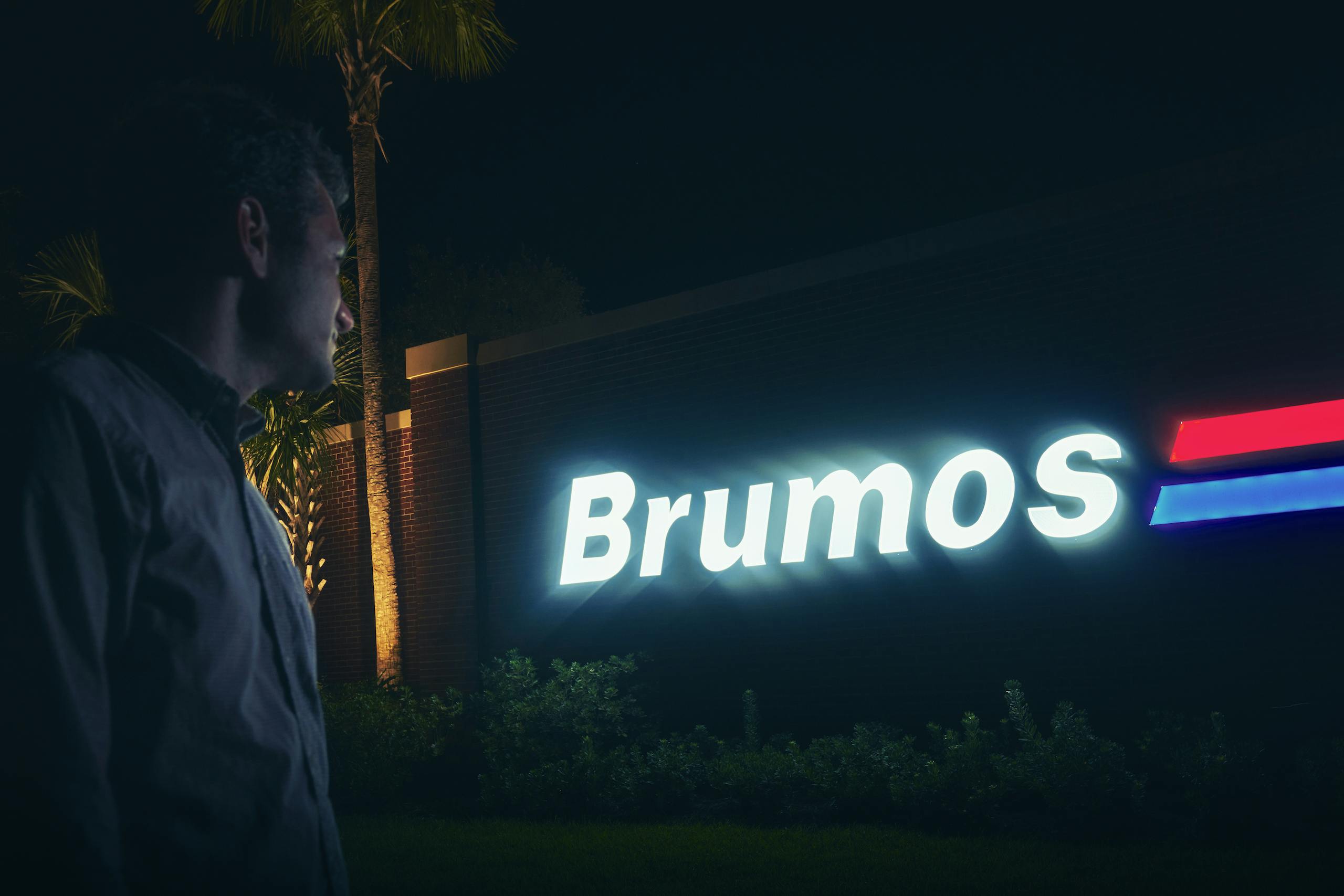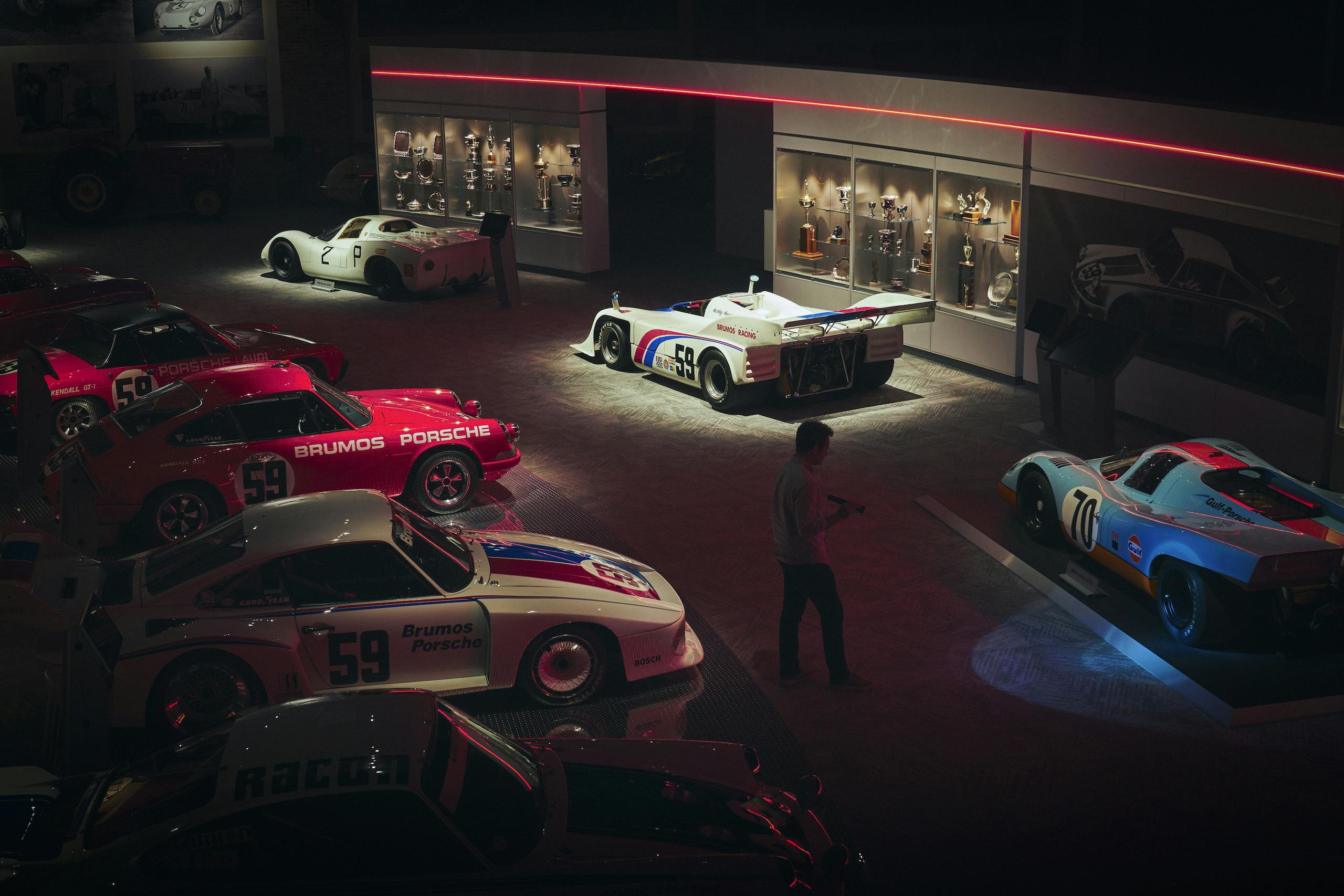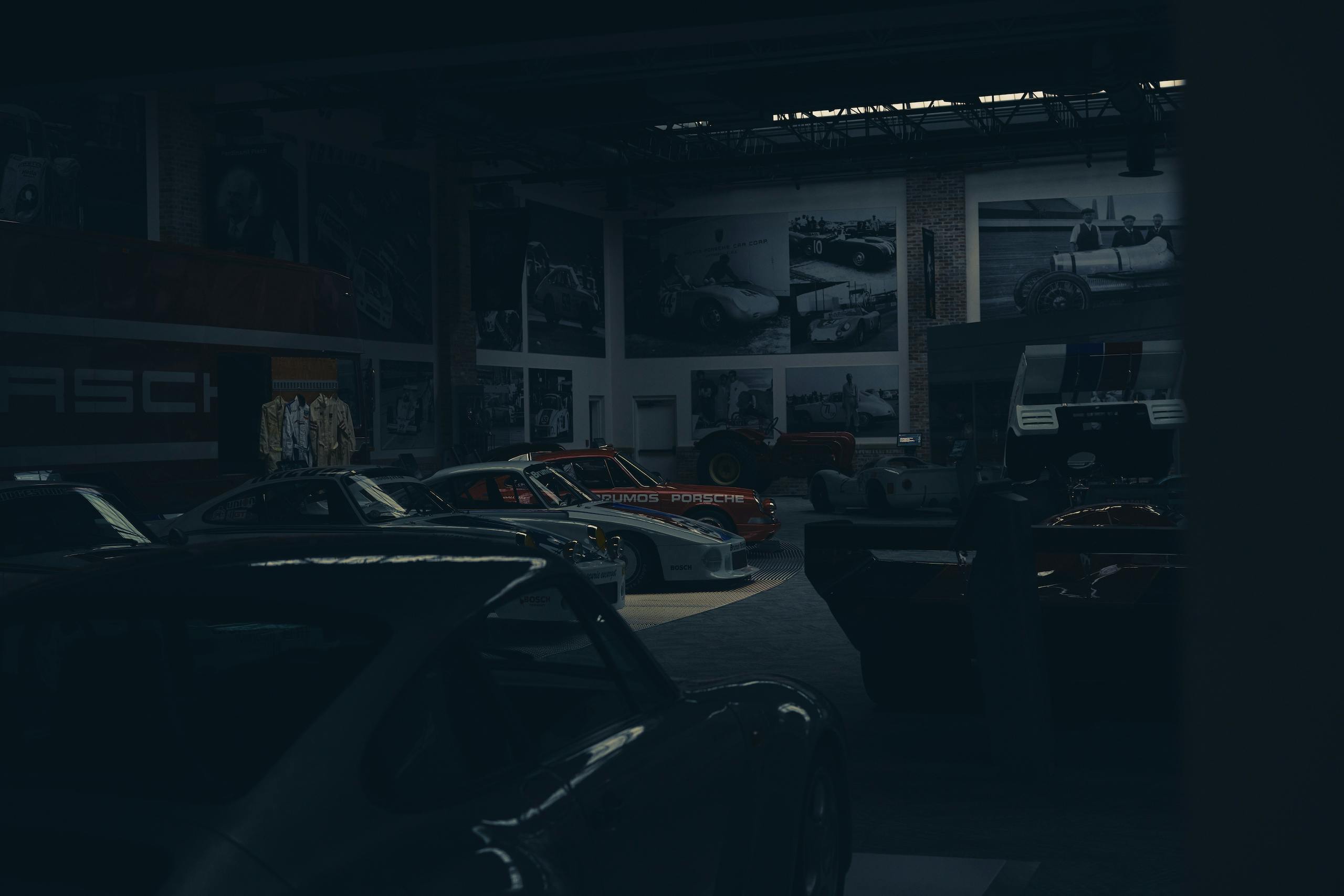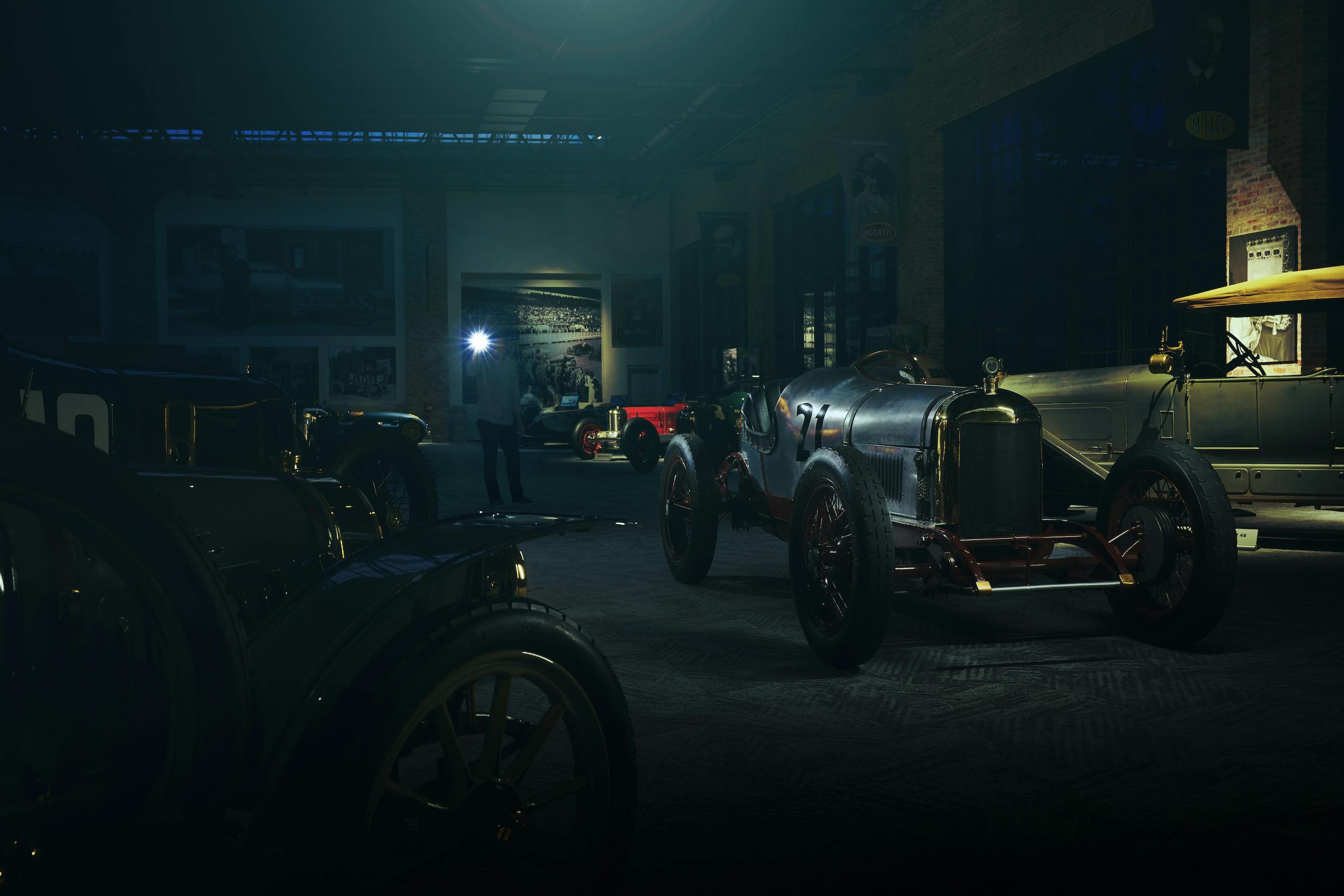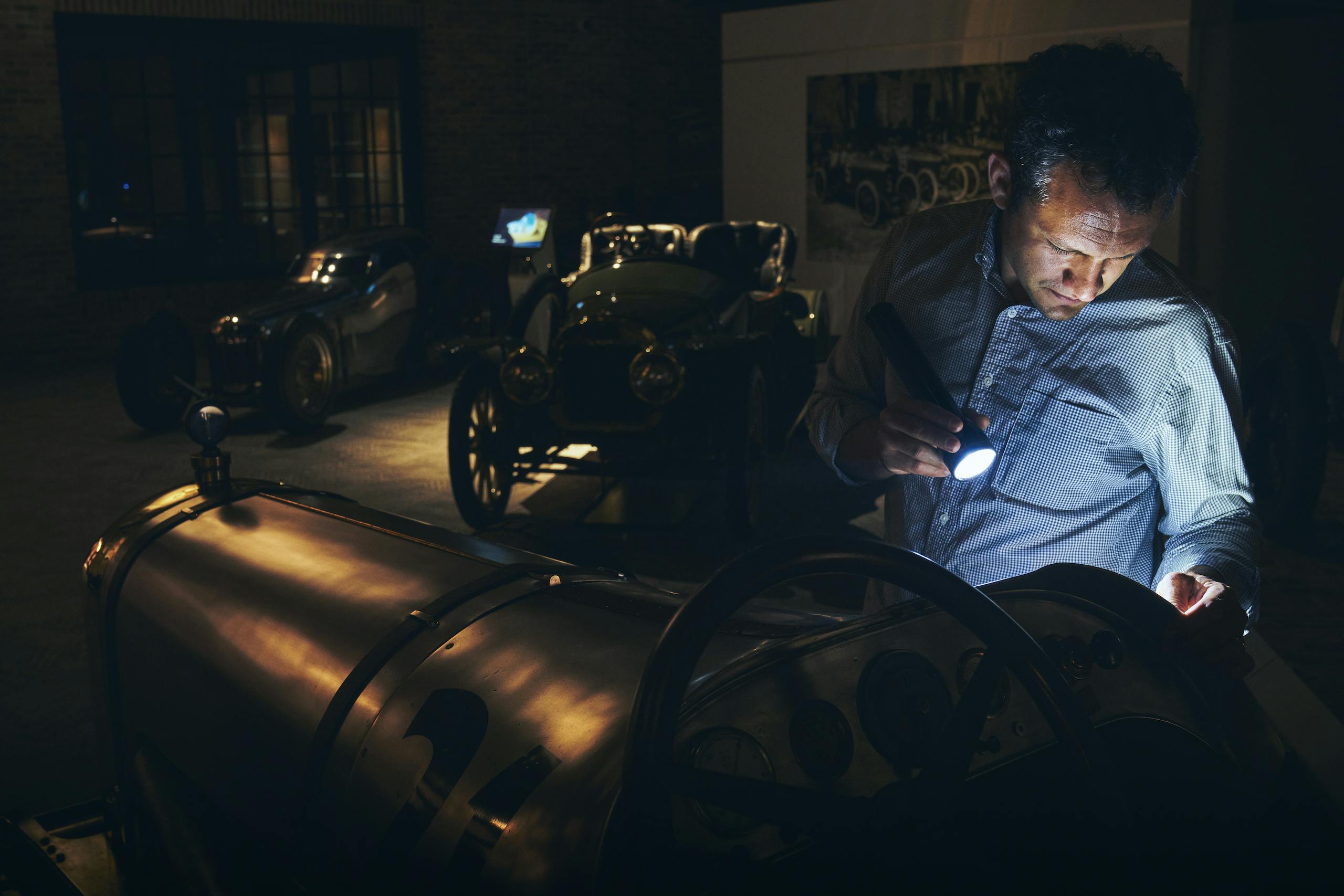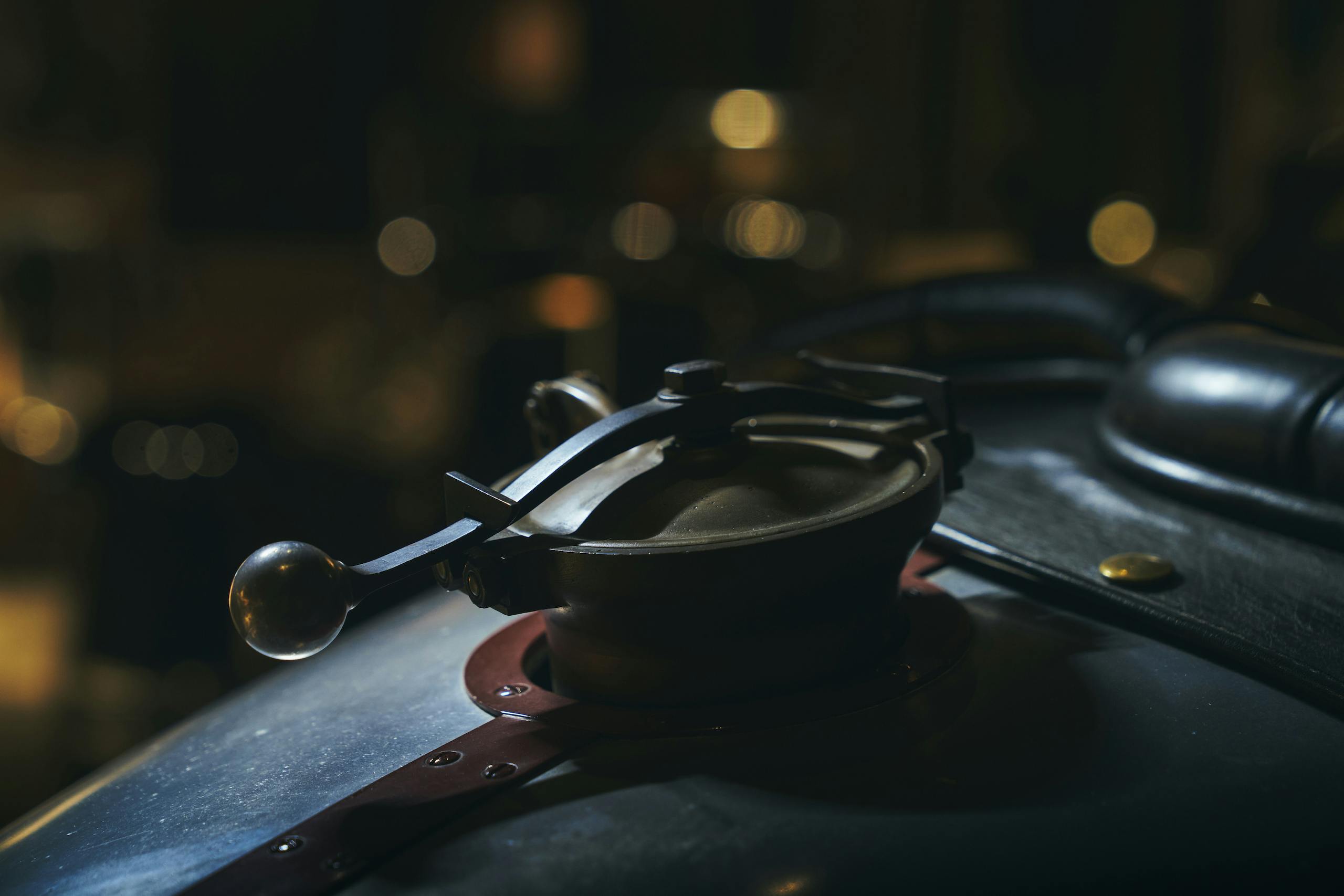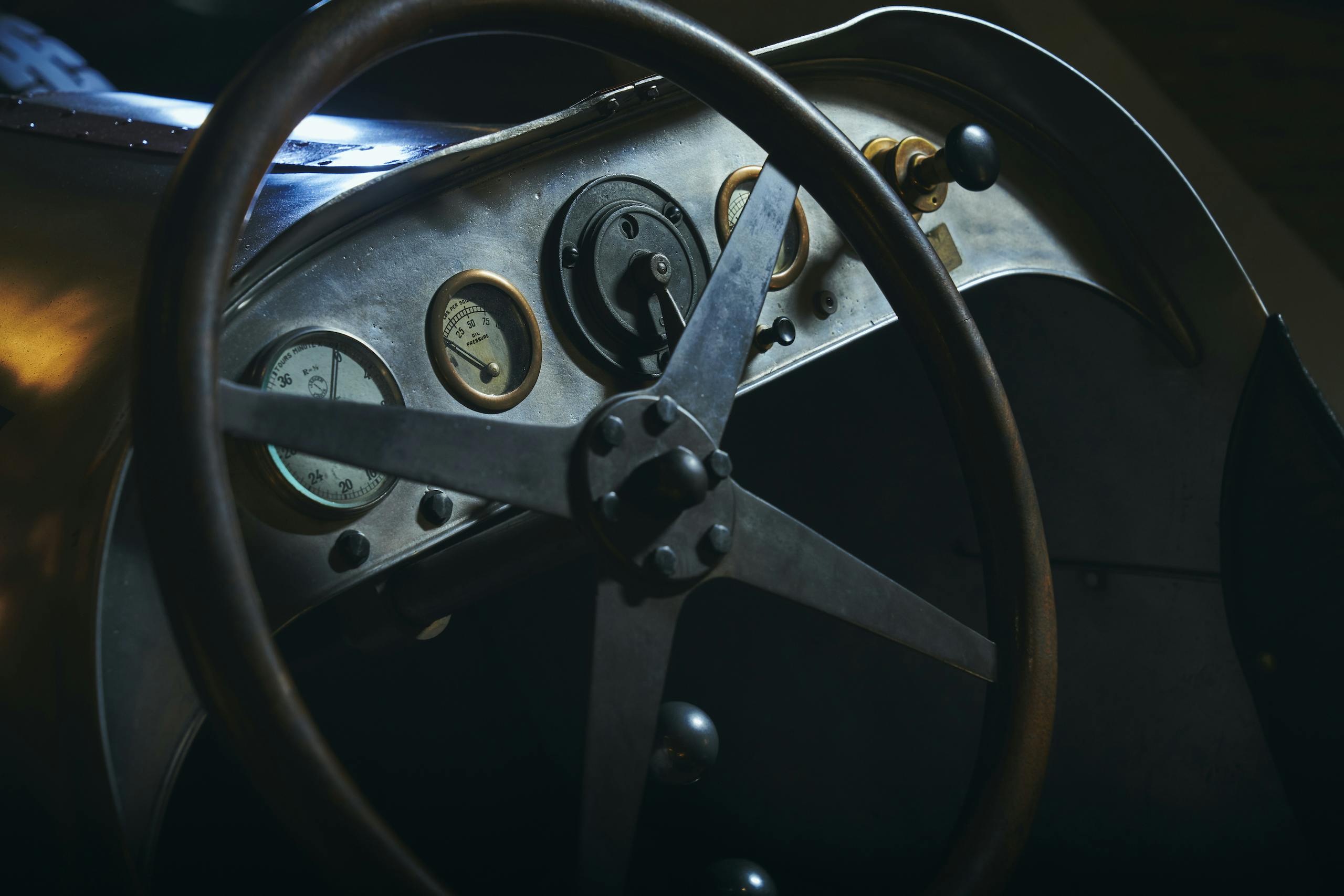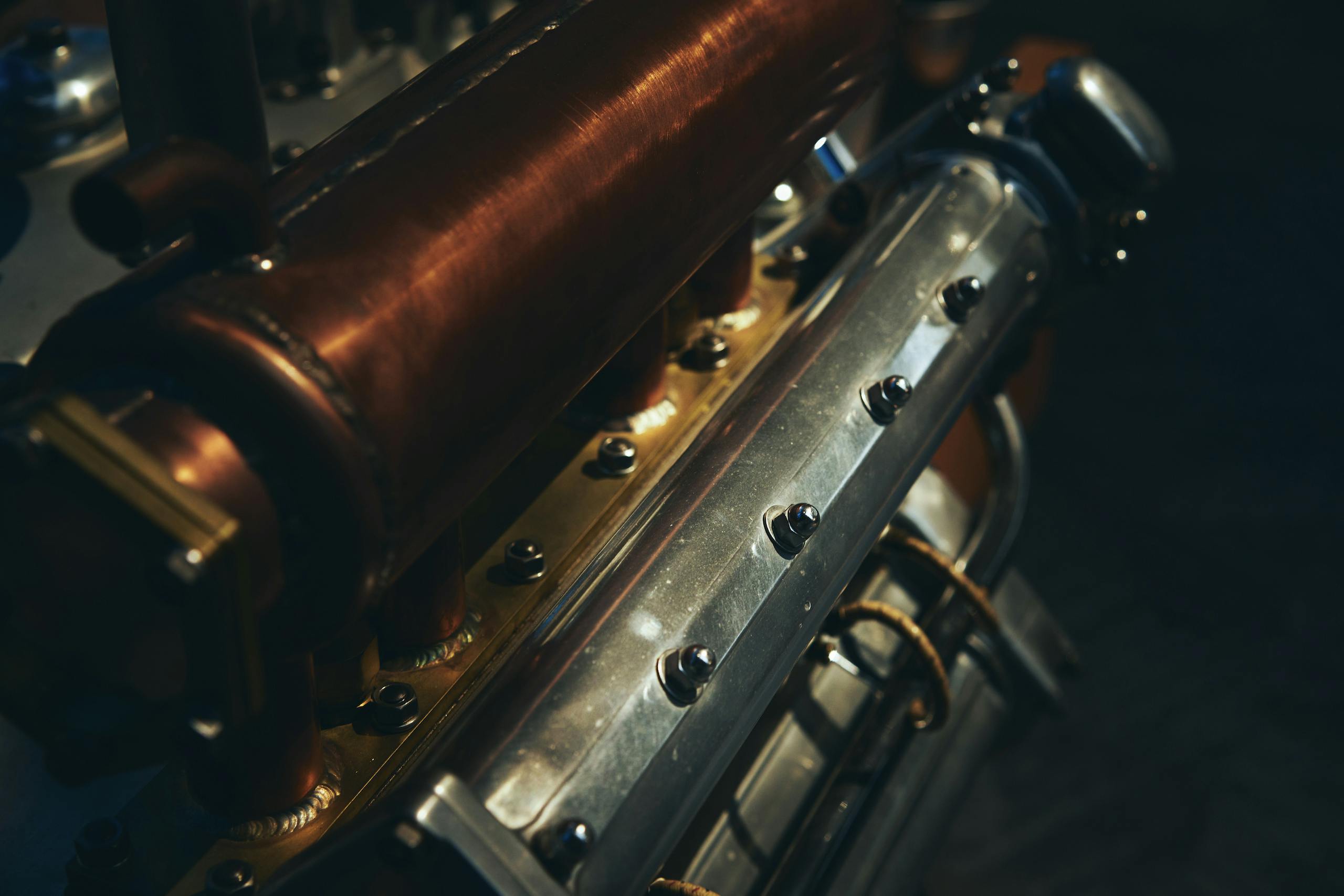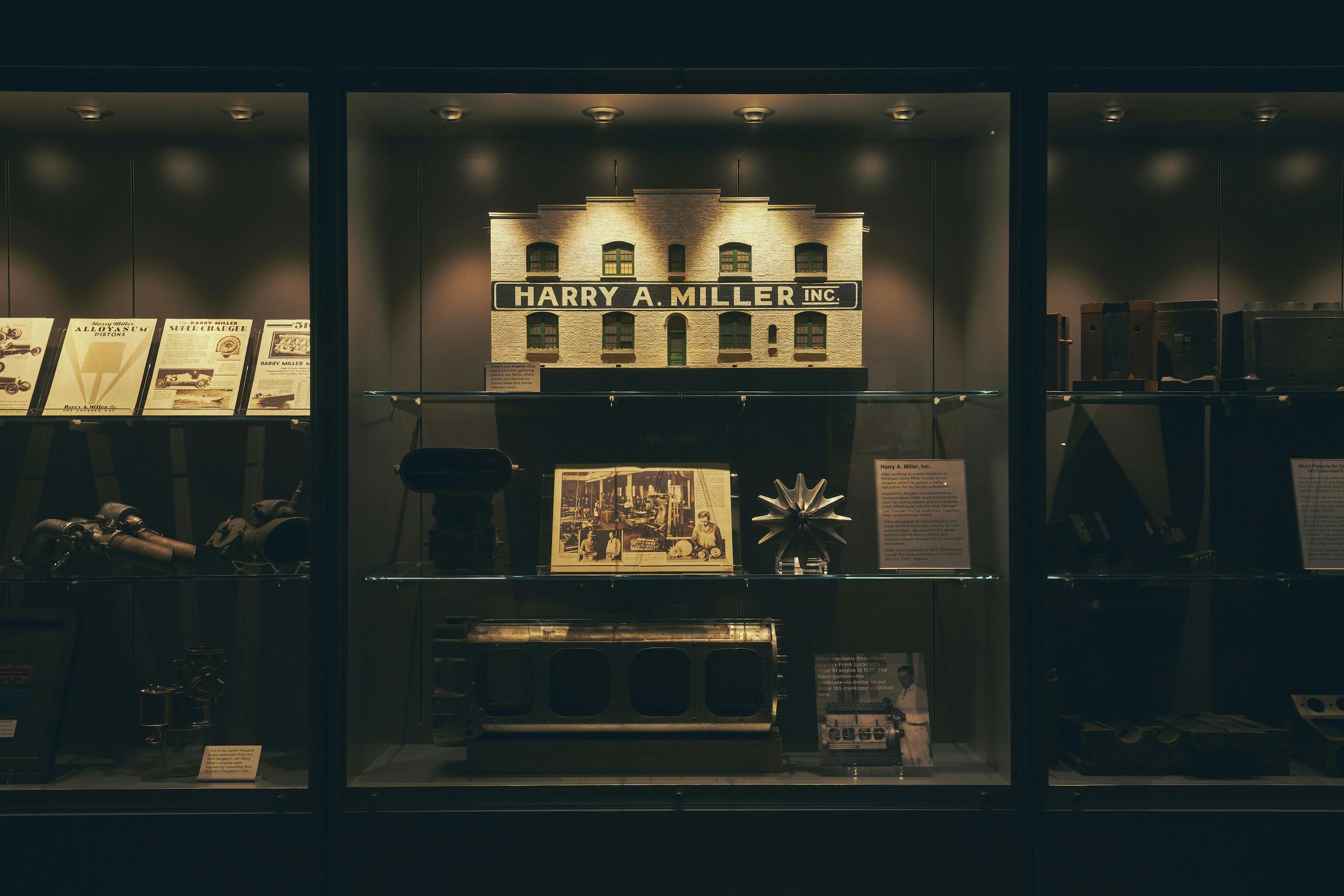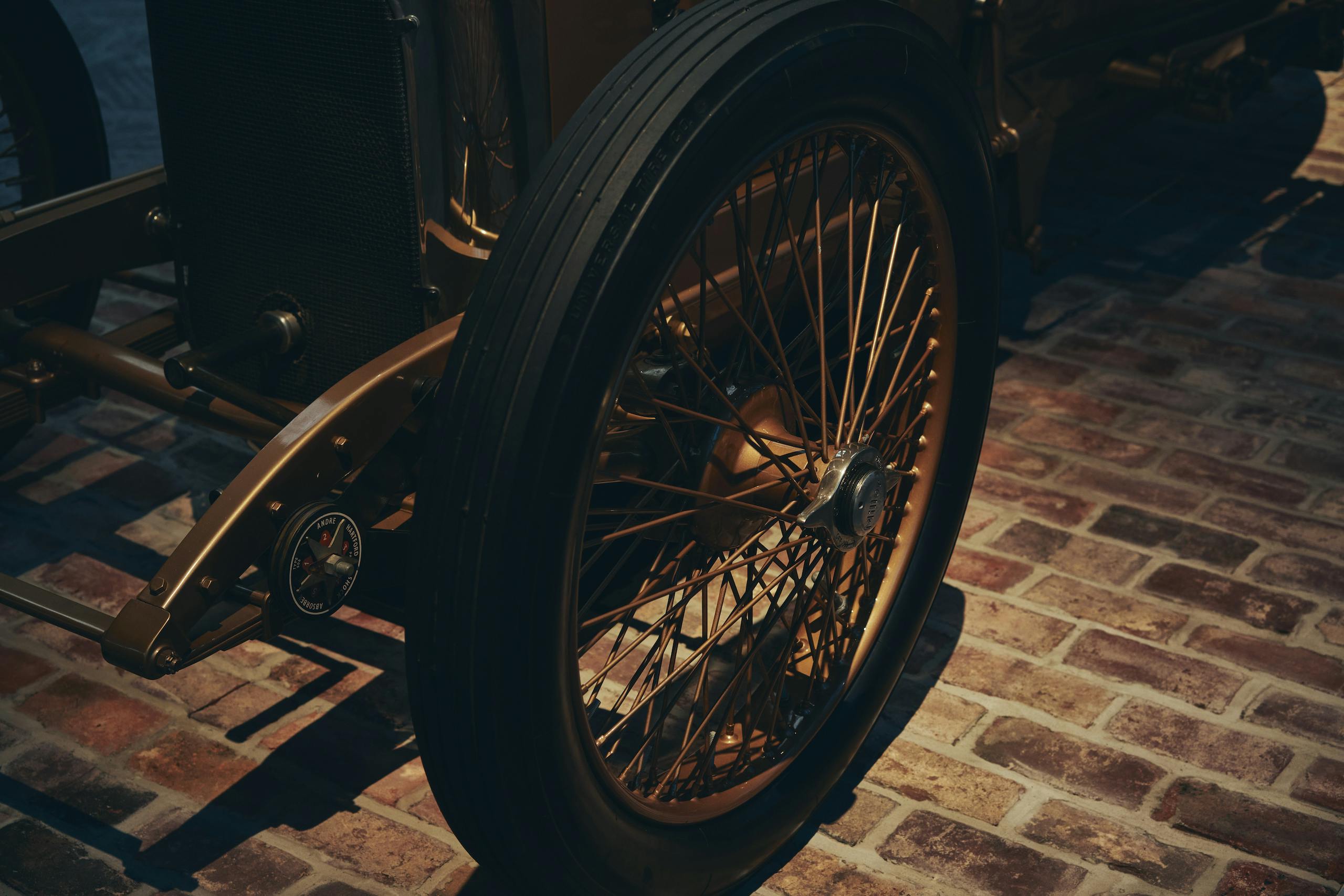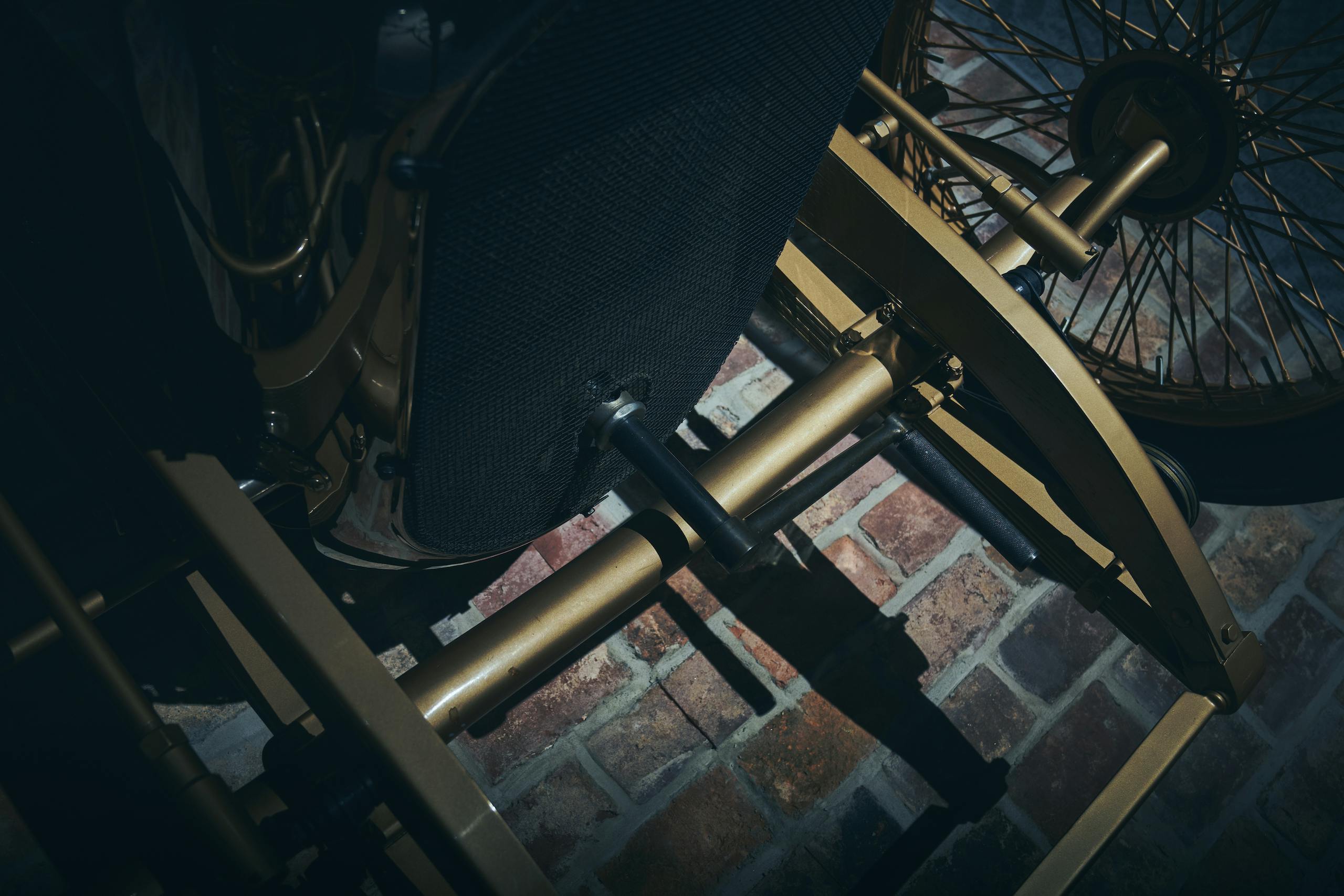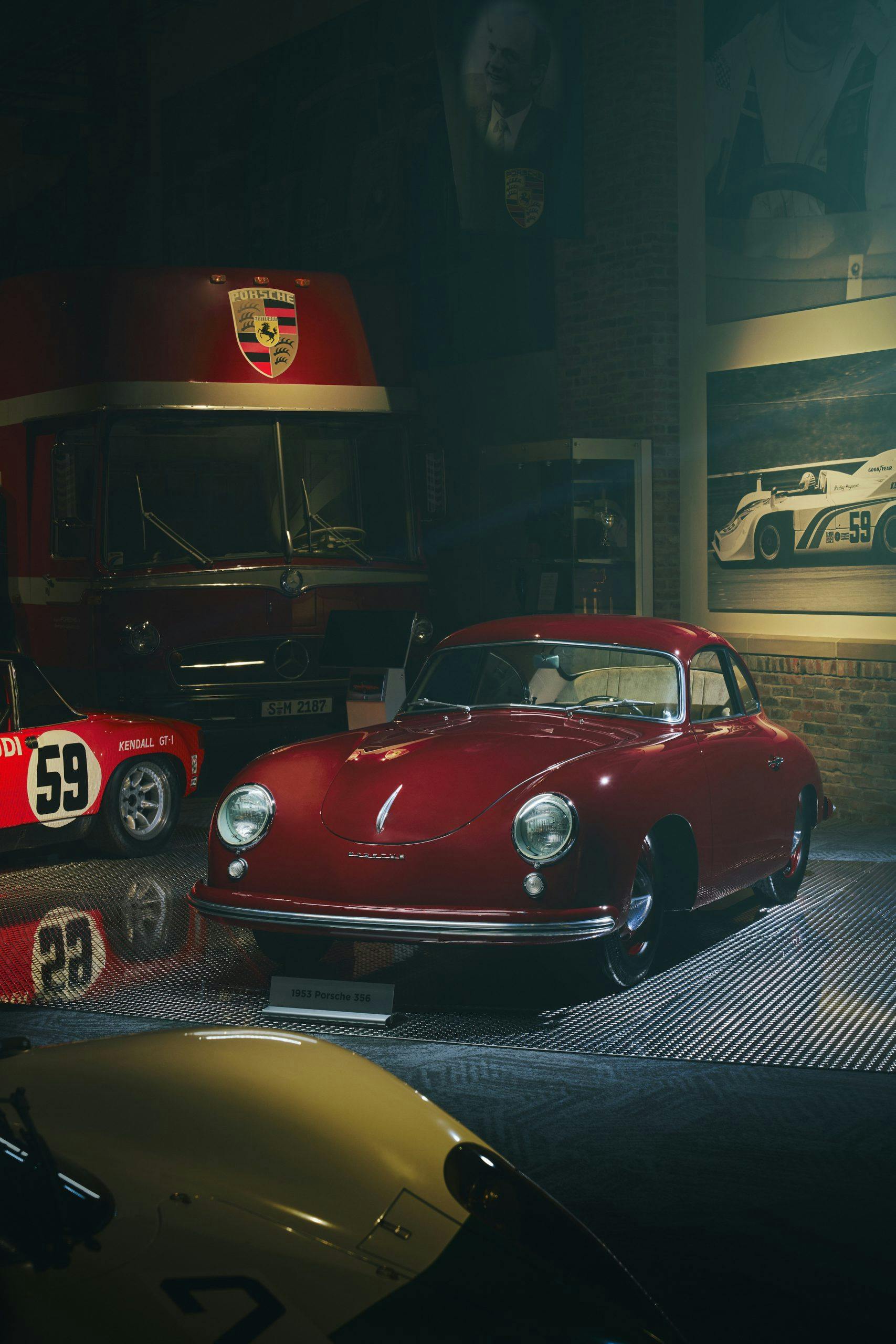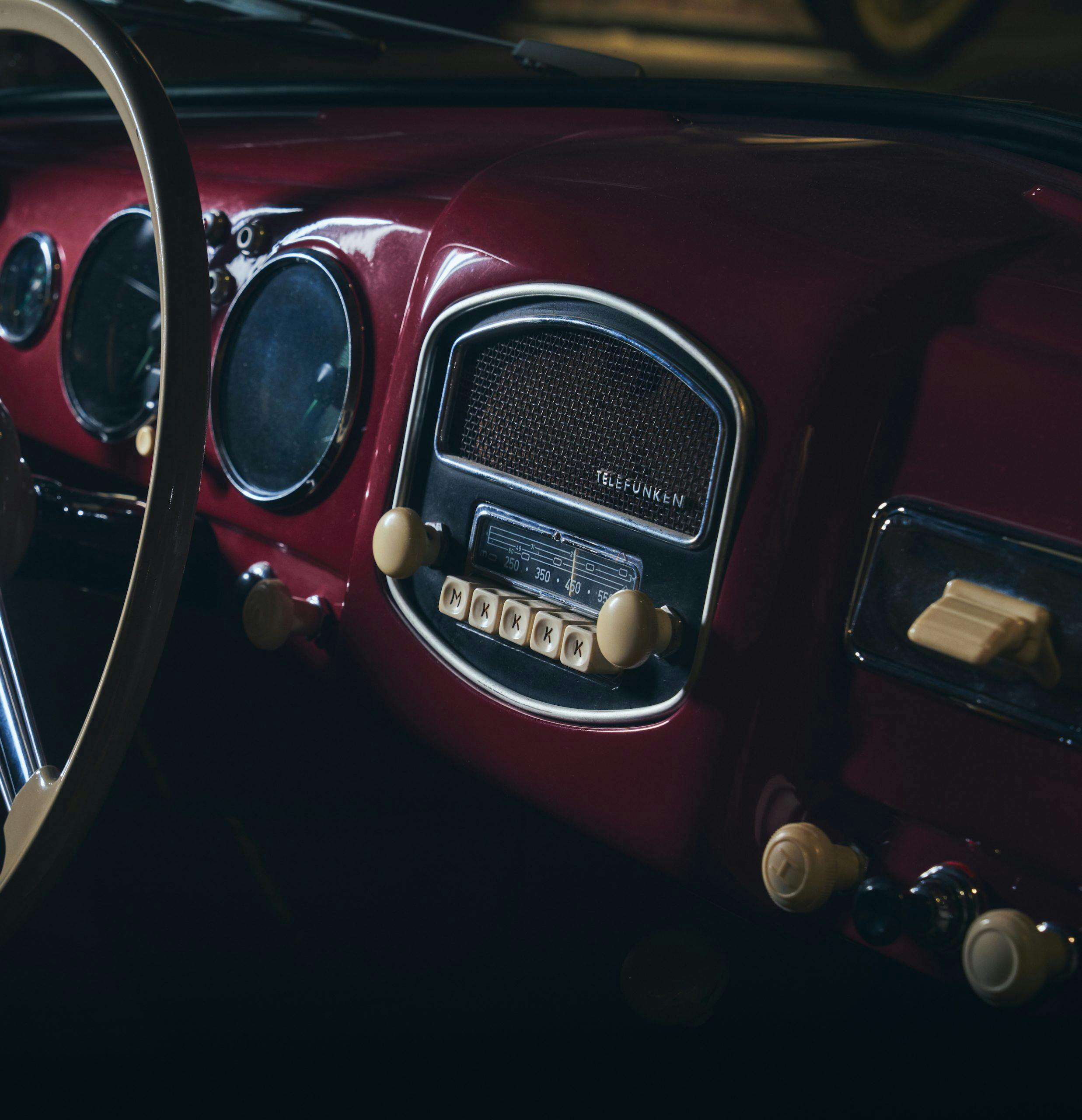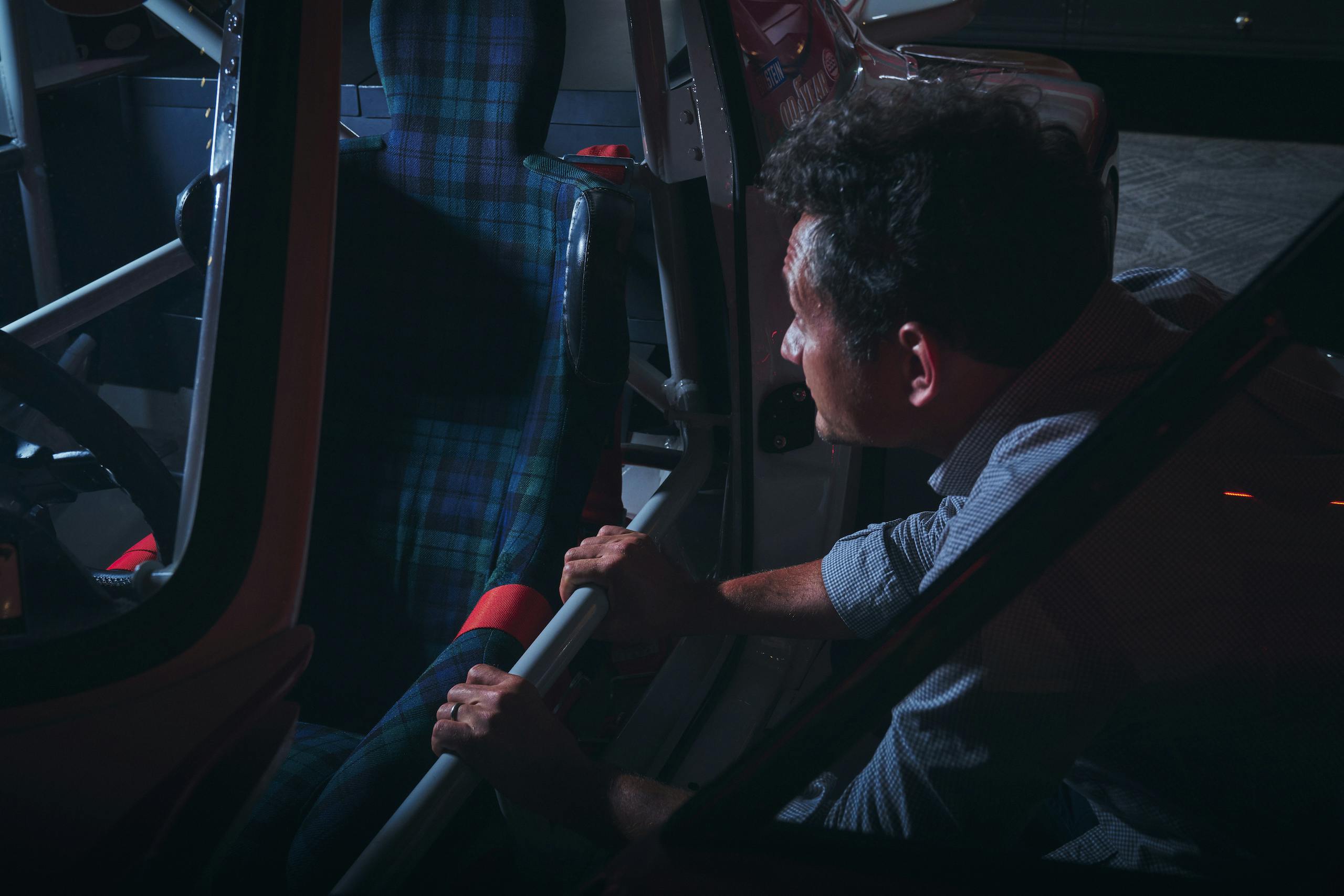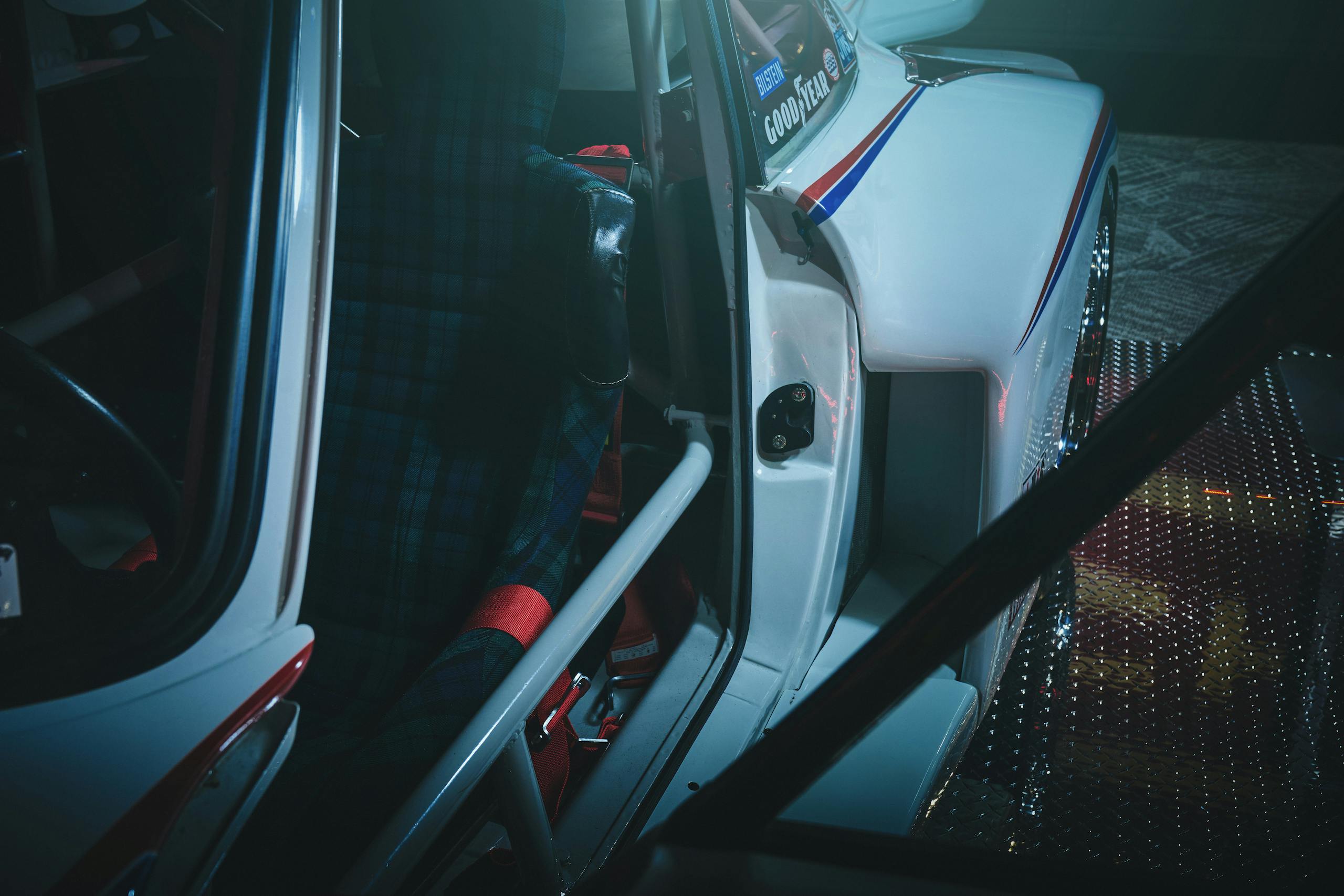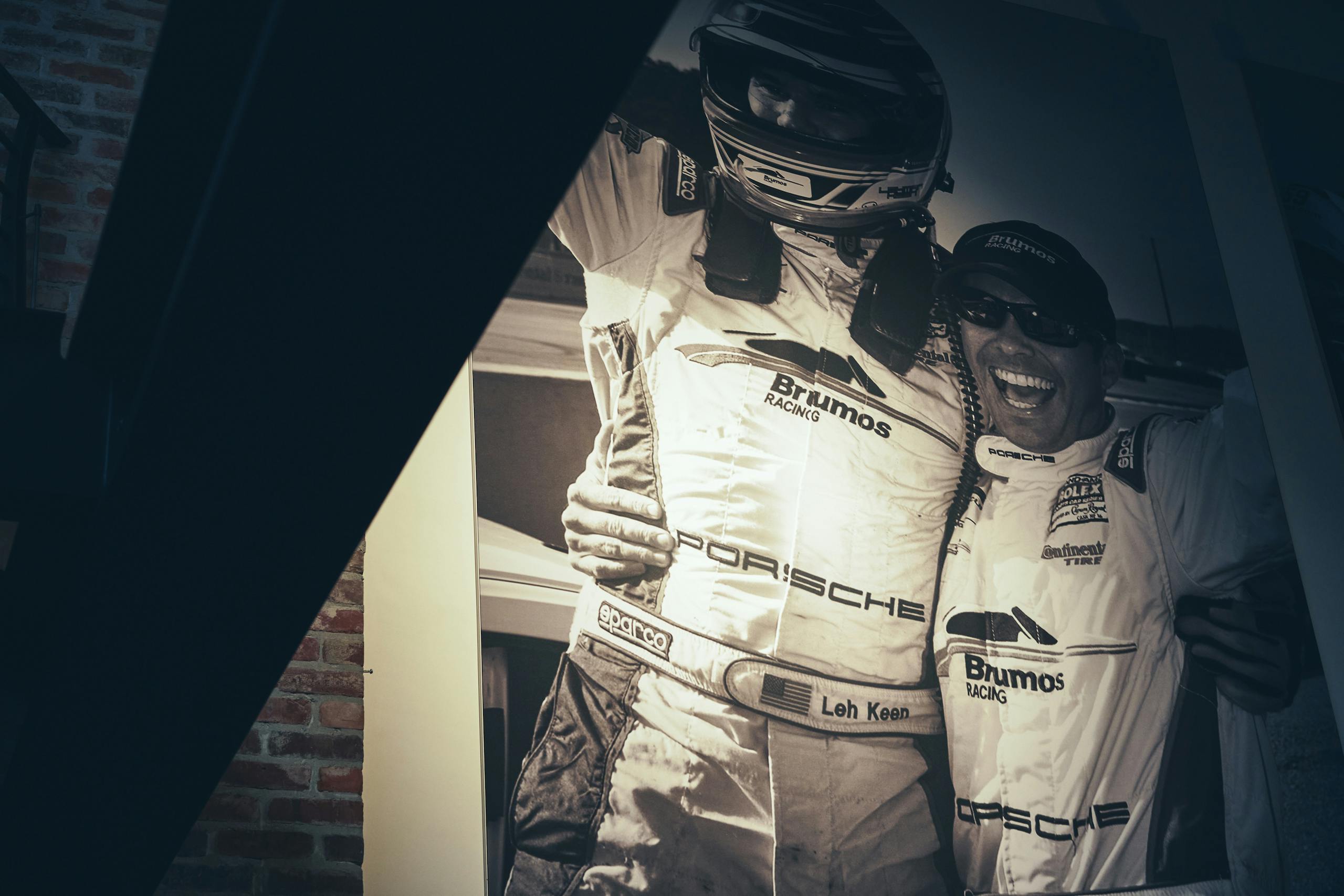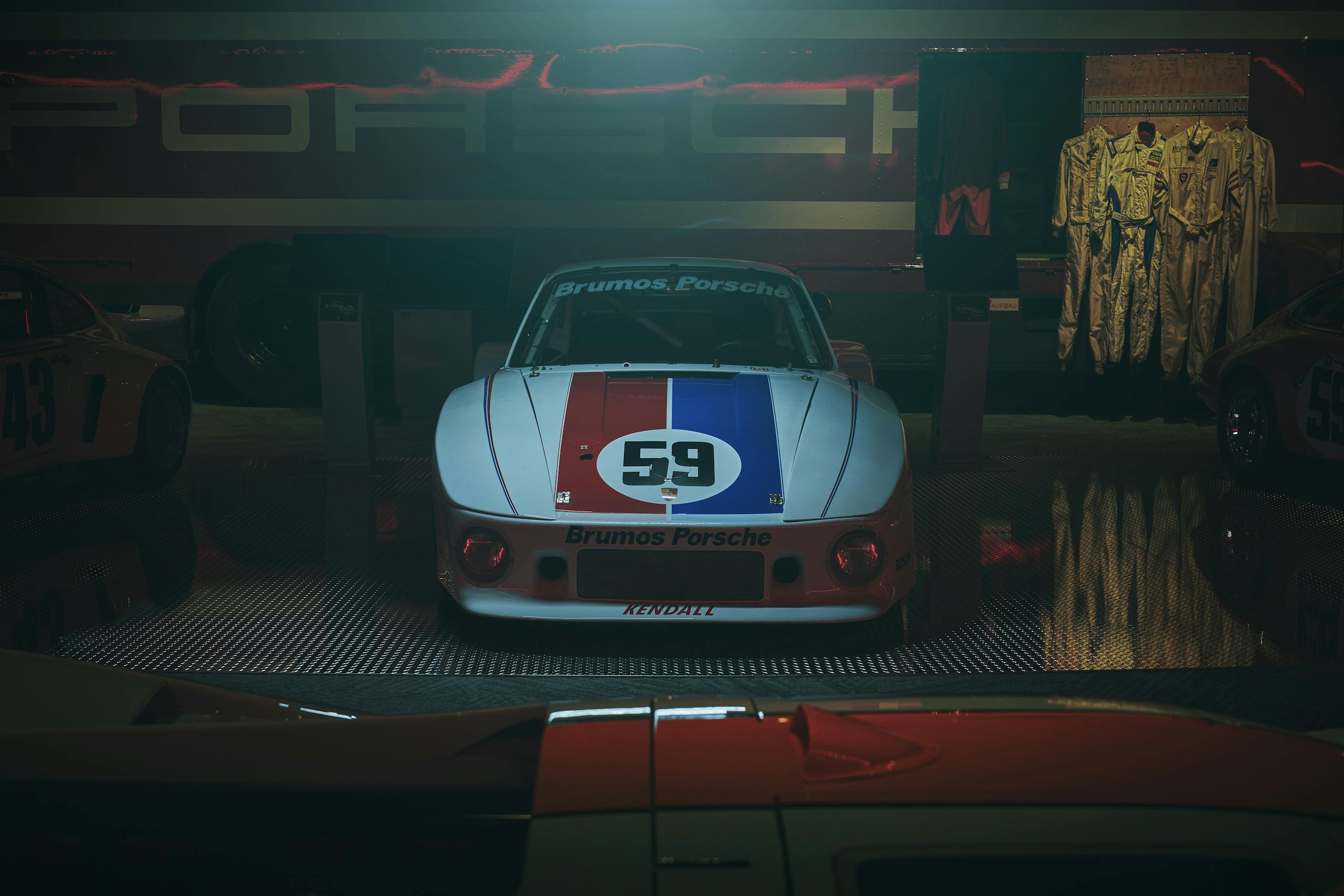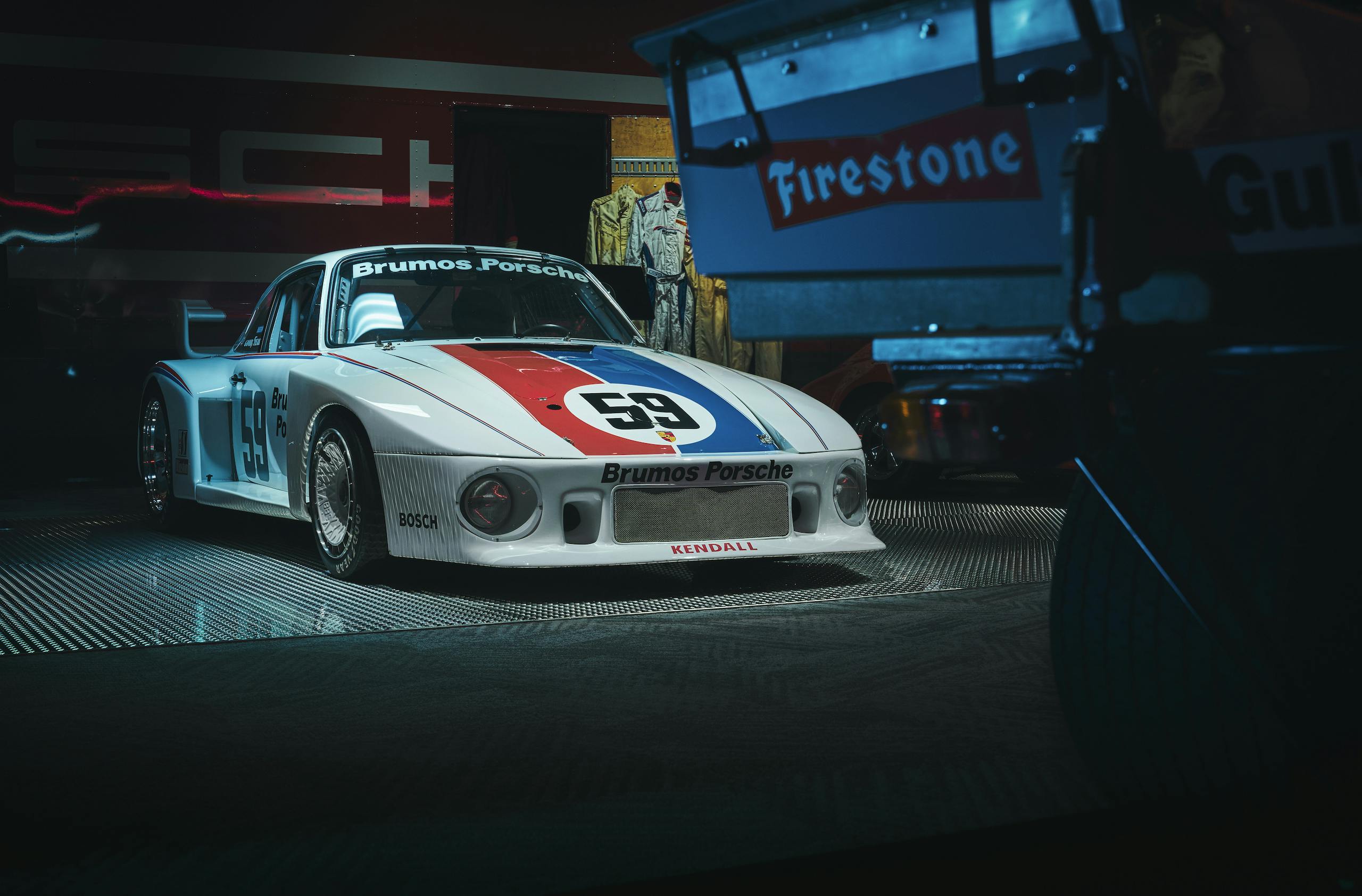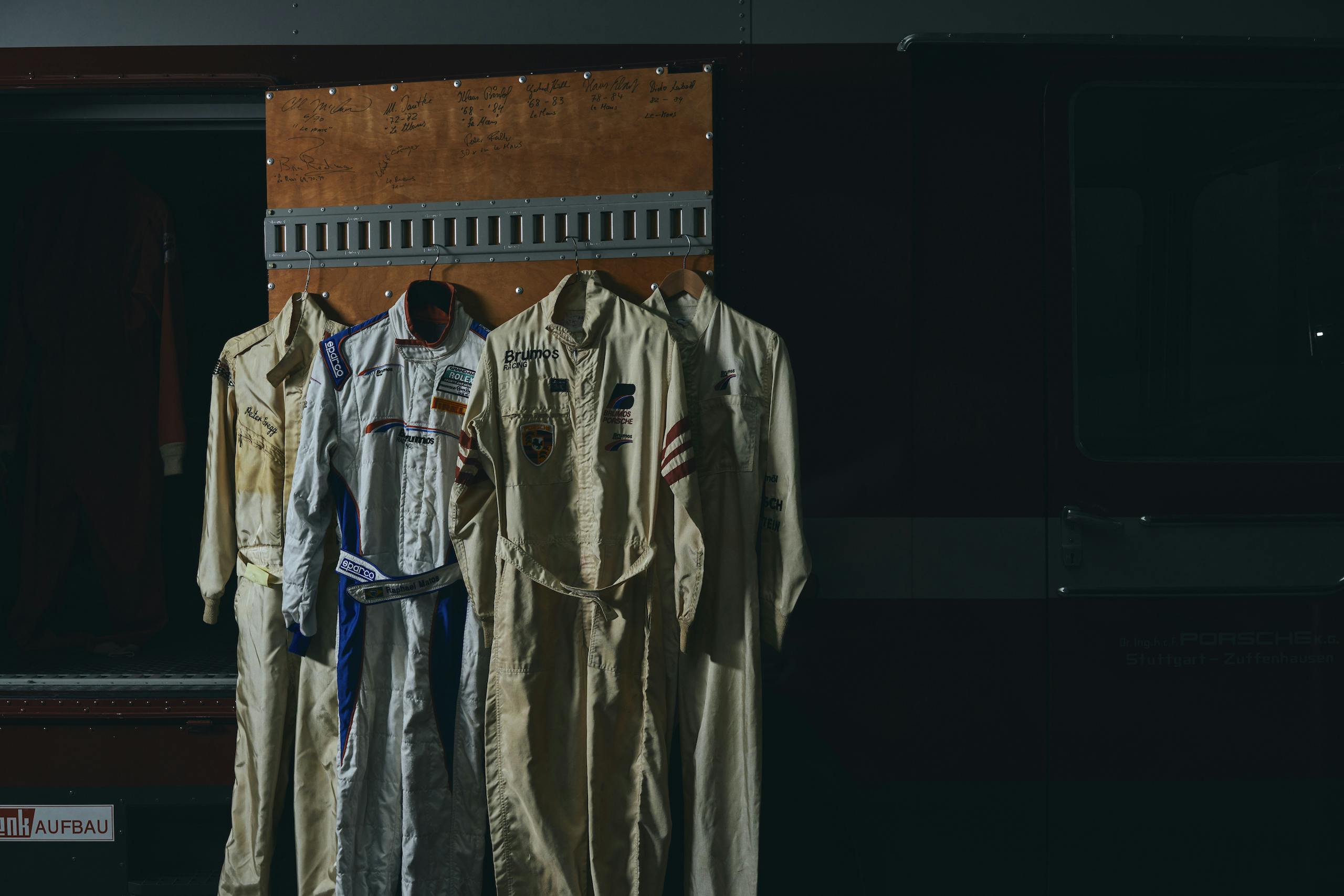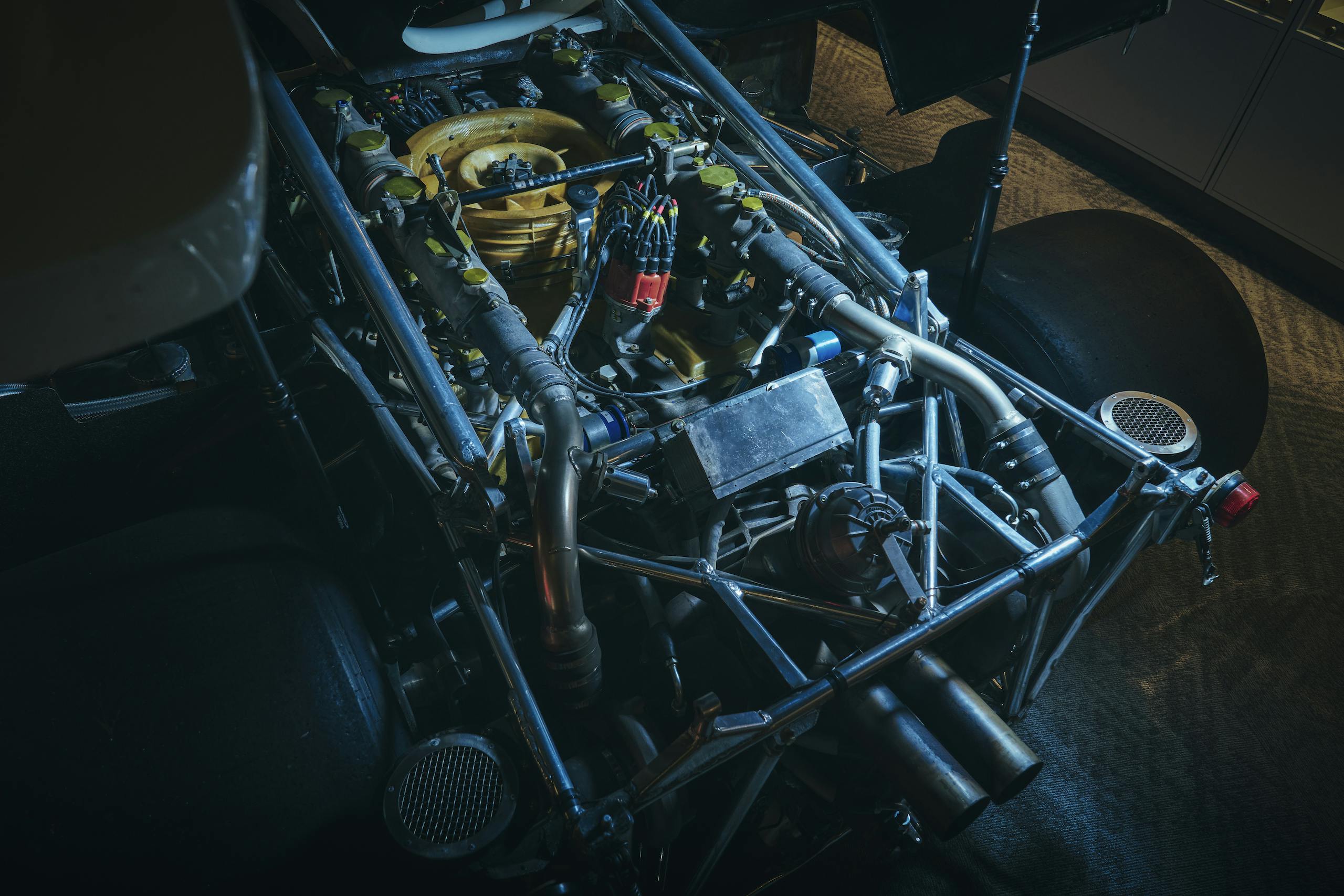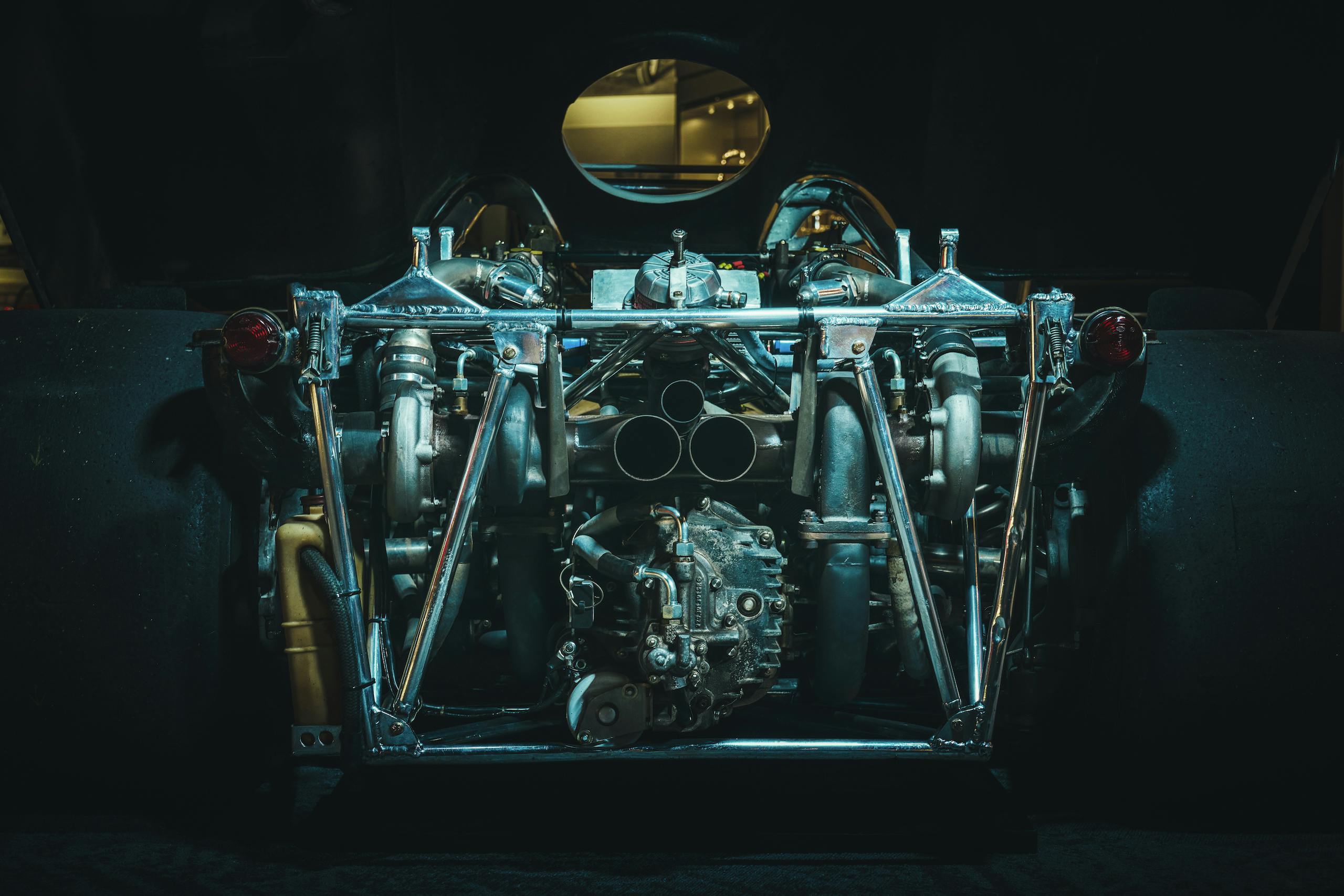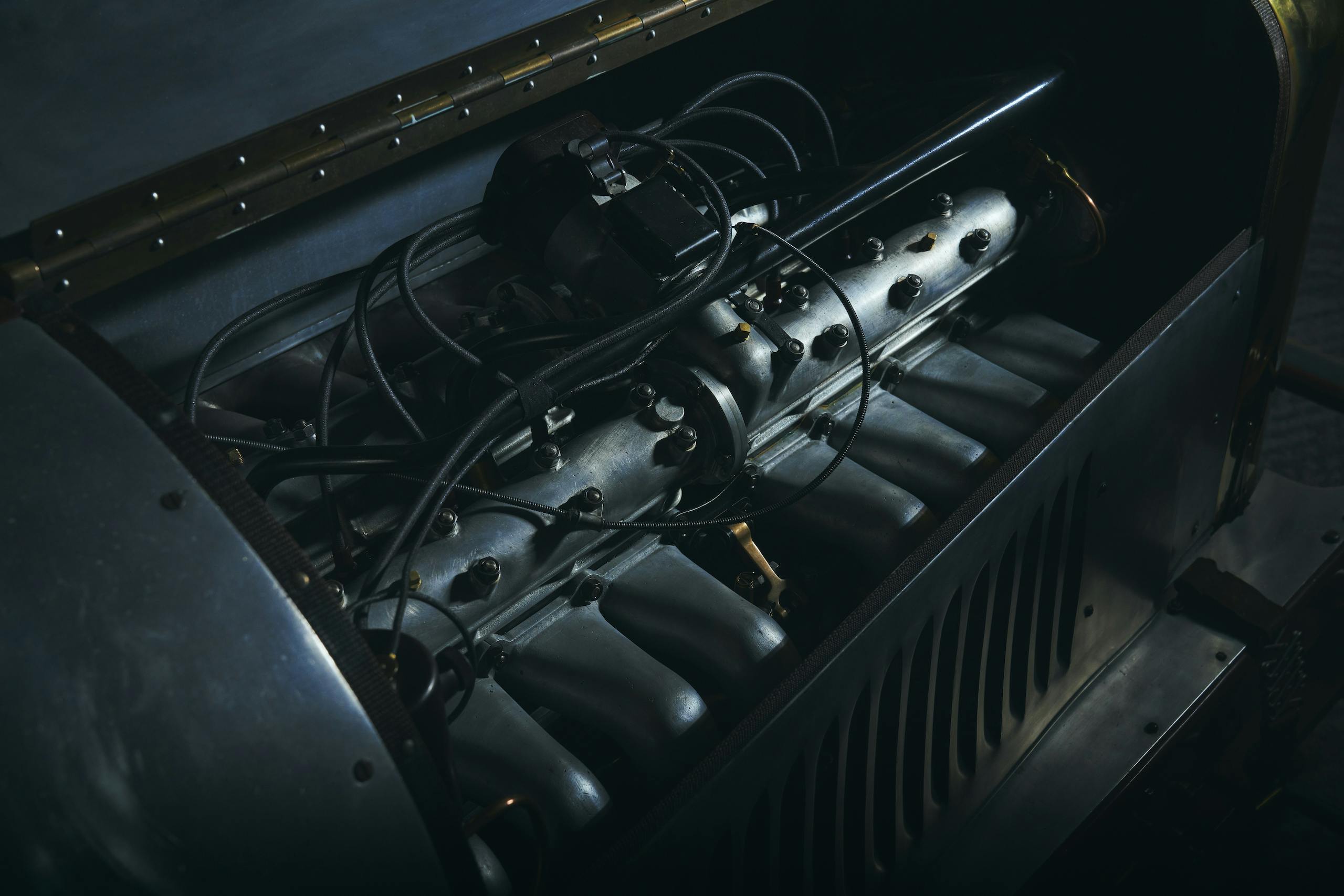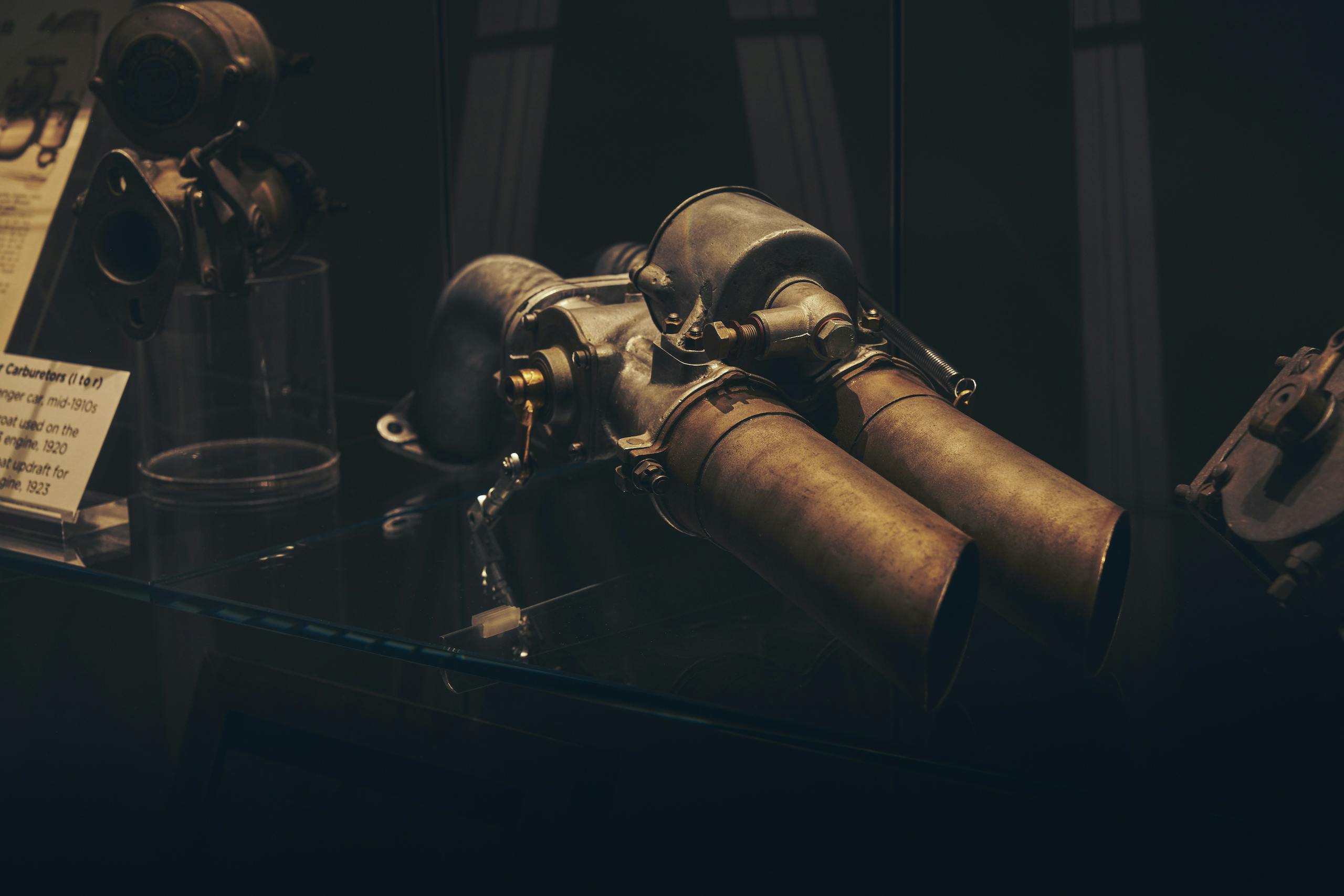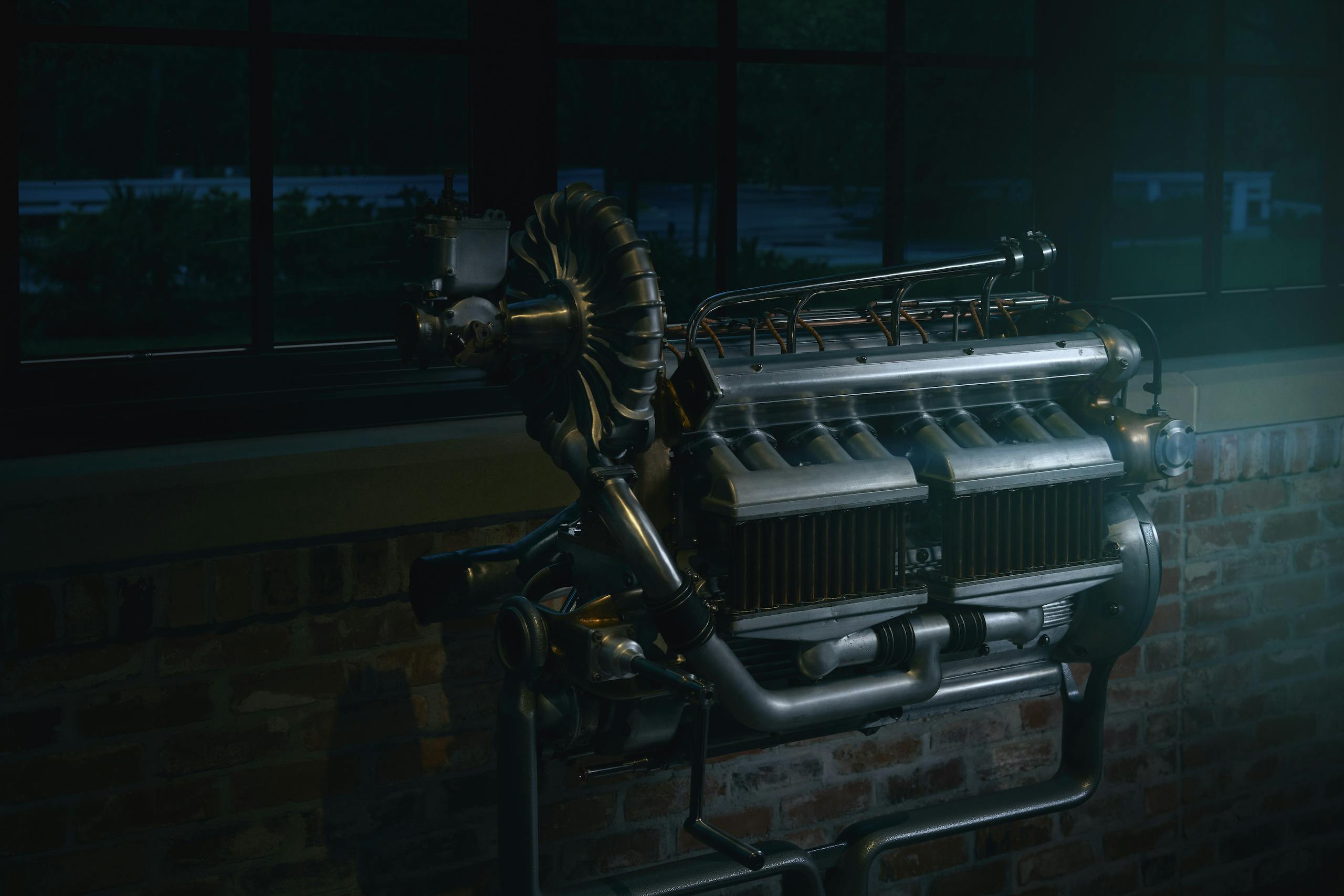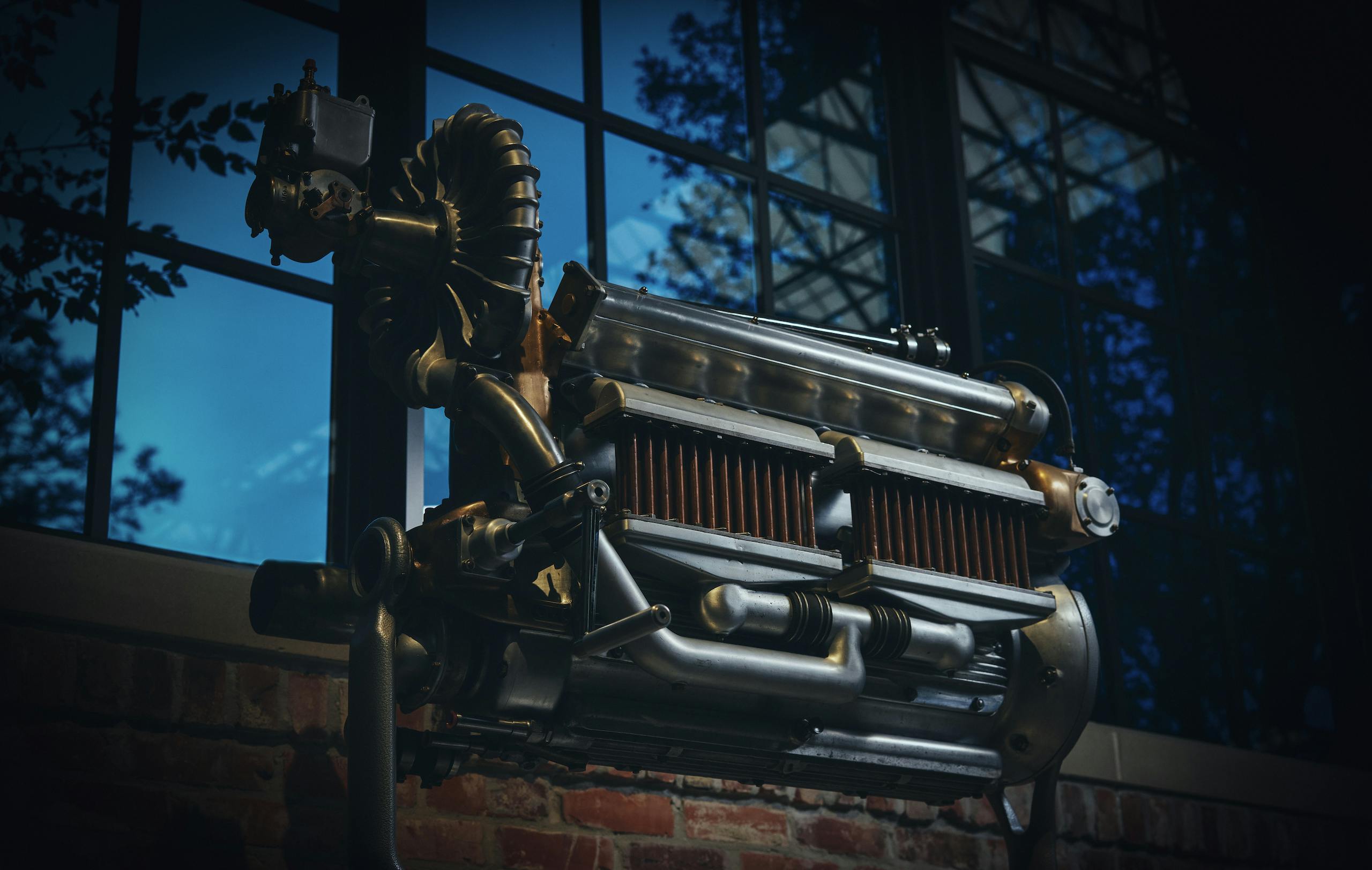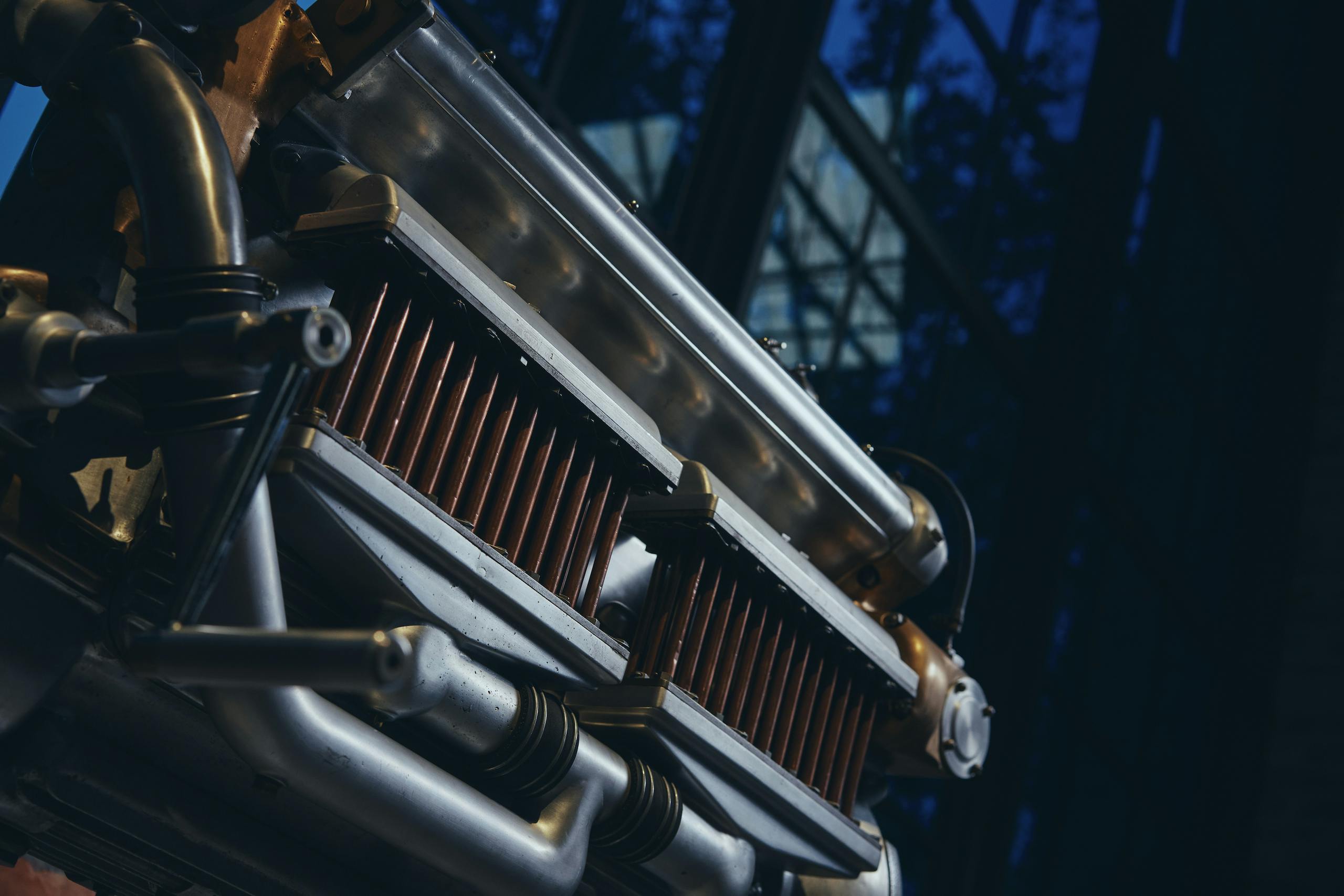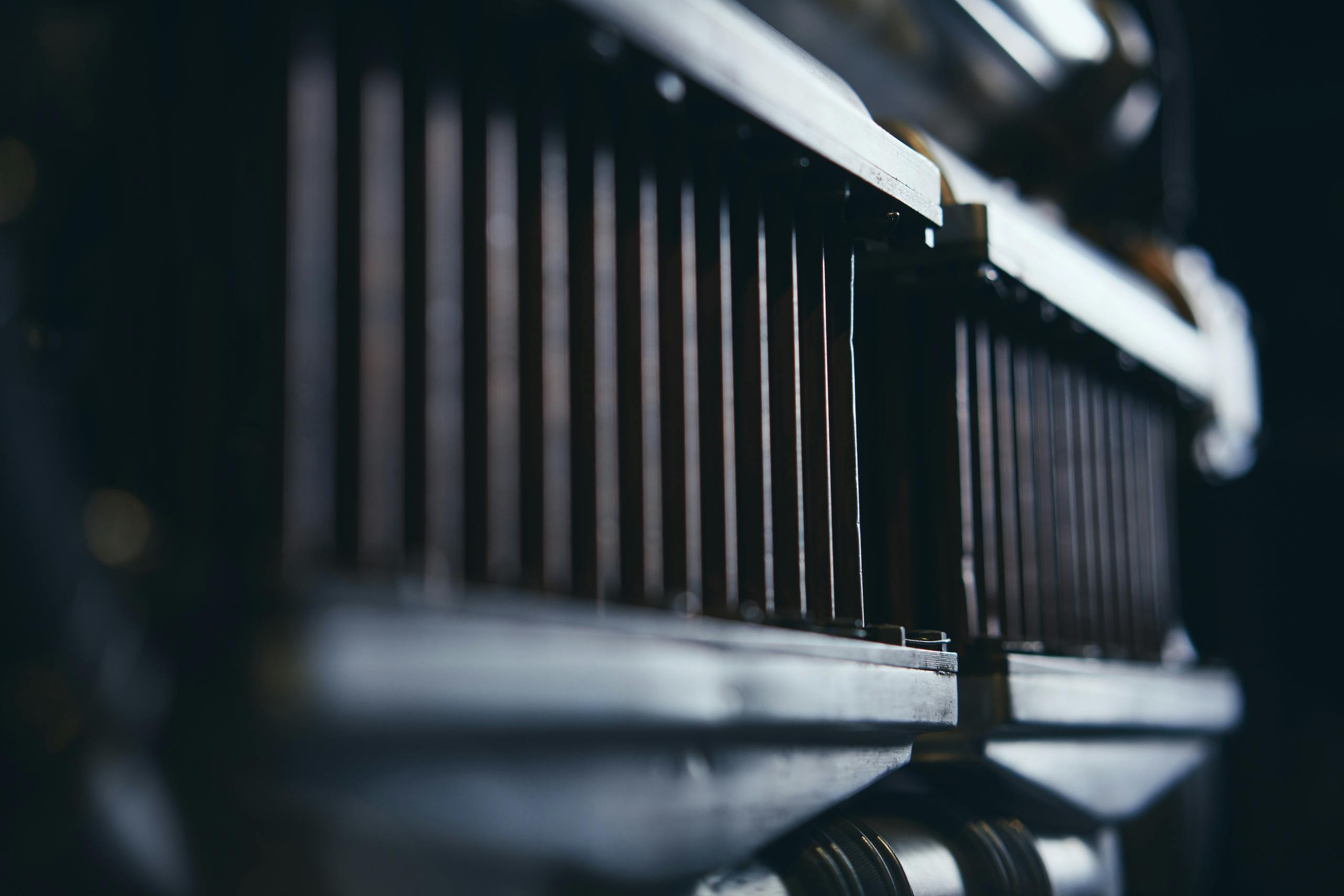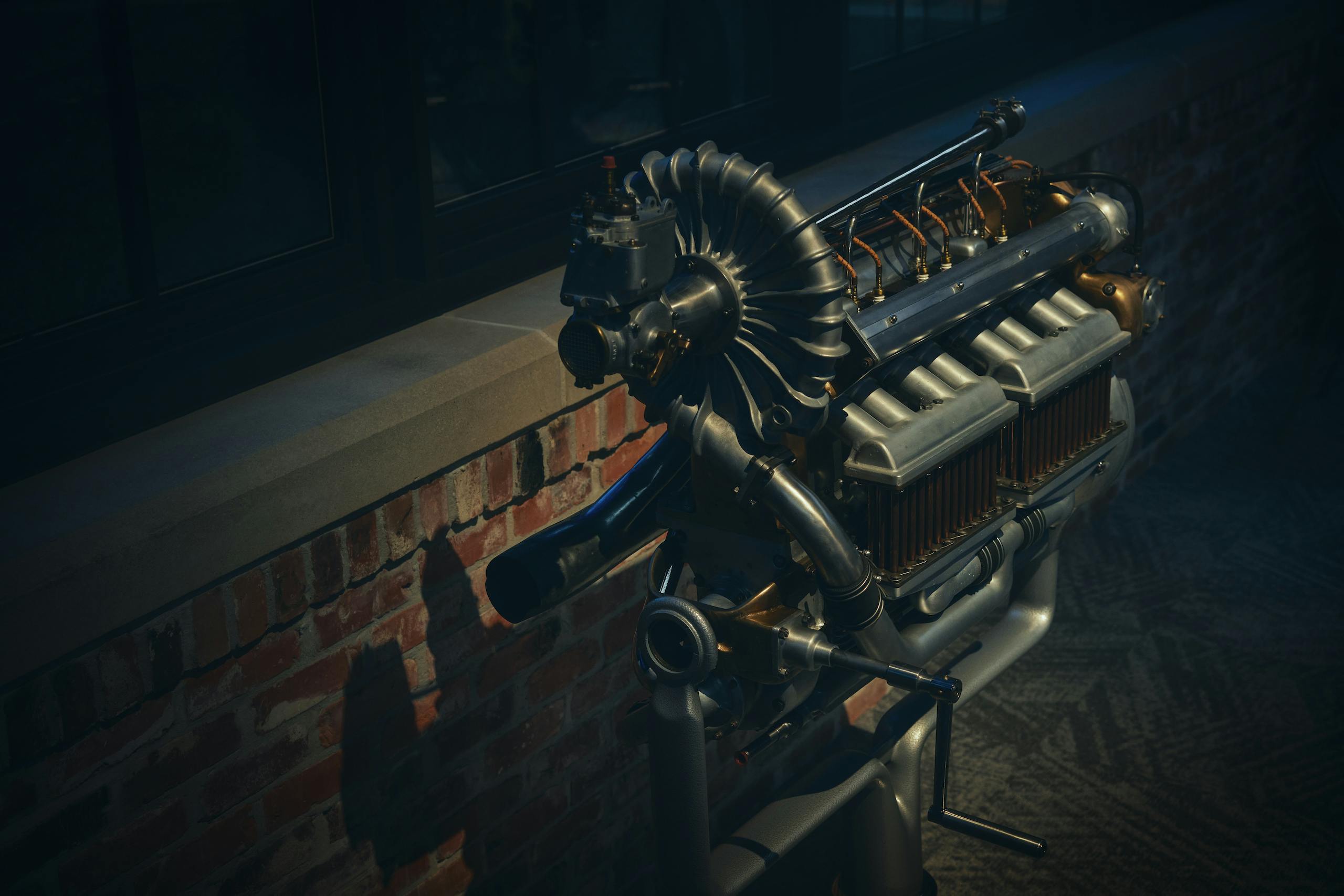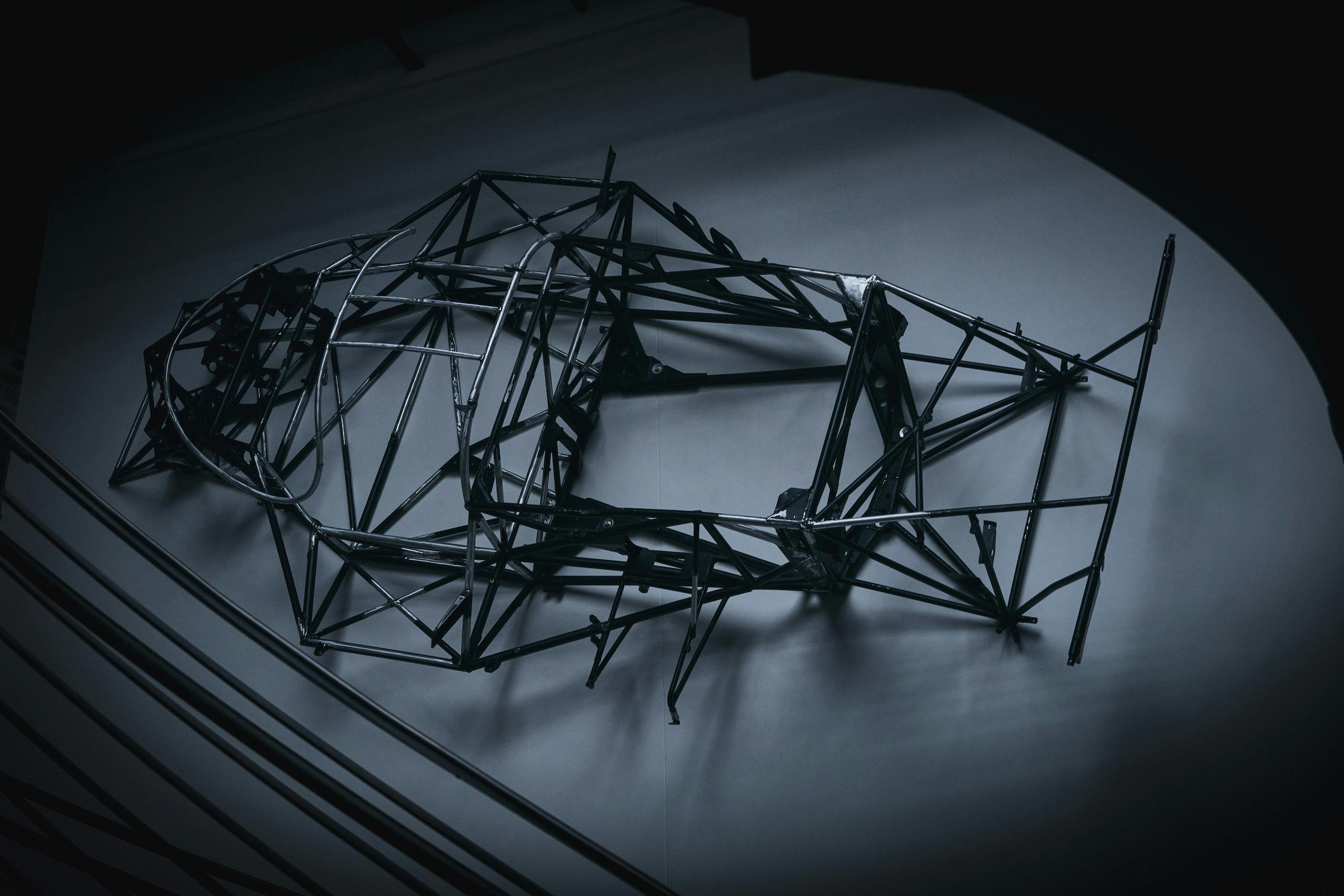Night At The Museum: The Brumos Collection
Night at the Museum is a new series from Hagerty—visiting car museums around the country, telling stories from the silence. In a year where public spaces offer unique resonance, we decided to visit our favorite automotive temples at night, when they’re empty and quiet. We brought with us a heap of curiosity and the keys to every door in the building, wheeled or otherwise. Enjoy. –The Editors
We hit Jacksonville in late afternoon, as the sky faded to purple glow. It was the aftermath of one of those Florida storms that comes and goes in five minutes—ominous walls of clouds, thousands of feet tall, and then clear sky a few minutes later.
The building resembles a 1920s Ford plant. There was one in town, in the early part of the last century, assembly for Model Ts. Dan Davis liked the architecture and what the place represented, so his museum, the Brumos Collection, was built to evoke the same feel, with brick walls and pyramid skylights.

The museum is essentially one big room, divided by era. The Millers live on one side, along with a few Peugeots and a Duesenberg; the other side of the room holds only Porsches. The walls are decked with life-size images of Ettore Bugatti and Harry Miller, but also Armand Peugeot and Fred Offenhauser. A chassis dyno, a couple of lifts, and a machine shop live in the workshop out back. The cars are clean but spotted with oil and dirt in places, far from perfect. They get used.
“This place was built partly out of necessity,” says Brandon Starks, the manager. “All of these cars were stored at Brumos Porsche, our dealer and race shop, when we were a racing team.” The team folded in 2013, after 42 years of IMSA competition. When the supporting dealership was sold in 2016, Starks says, “Dan realized that he wanted to share all this.”

The Dan is Dan Davis, the former chairman of Winn-Dixie and one-time co-owner of the Brumos group of businesses. His partner, Bob Snodgrass, died in 2007. The two men were first-name famous in IMSA circles and famously garrulous; the museum that Davis opened serves as tribute to their efforts and passions.
Around 40 of the collection’s 60 cars are on display at any given time; the majority are racing or engineering landmarks, and around half were built in Stuttgart. But the facility also hosts one of the world’s largest public collections of Miller race cars and memorabilia—the hyper-rare and jewellike machines that dominated Indianapolis in the 1920s and 1930s and are widely believed to be the prewar pinnacle of American motorsport engineering.
In the evening, once those skylights had dimmed, little spots of yellow began to appear among the bricks—moonlight trickling through the windows and reflecting in old lacquer. There were too many stories to count.
A flop of genius

1919 Miller TNT
To get it right, you must first get it wrong.
From 1922 to 1976, his cars or engine designs won the Indy 500 a whopping 39 times. His small Los Angeles firm helped give the world practical front-wheel-drive, practical four-wheel-drive, and streamlining. As early as 1917, he was telling journalists that an inverted airfoil—a wing—could aid the traction of an ultra-light automobile. His record-breaking race cars were so potent and well-finished that Ettore Bugatti bought two for study in 1929; one of those cars, capable of more than 150 mph, is now in the Smithsonian.
You have probably never heard his name.

Harry Arminius Miller was born in Wisconsin in 1875. He was an idea man, not an engineer, but he had a knack for hiring talent. The cars built in his Los Angeles shop are of an era so different from ours that they can be difficult to process: In an age where 700-hp pony cars with factory warranties virtually fall off trees, how do you ask someone to care about a spindly little hundred-year-old racing device with a fraction of that power?
You start with the board tracks, for one. Imagine an oval racing surface, a mile or more in length, built of two-by-fours nailed together on end. From 1910 to 1931 this country boasted 24 such tracks coast to coast. By the late 1920s, the fastest of them would let a contemporary Miller Indy car lap at more than 140 mph. Pole speeds at the Indy 500 were then around 20 mph slower. And the boards were deadly, more so than the bricks. Planks would come loose and catapult cars airborne, or men would simply be flung off the top of the track—no guard rails—and not come back. Race wins on the board tracks made national headlines; deaths did not.

The boards helped define Harry Miller’s work. The Brumos Collection’s 1919 Miller TNT—optimistically named for the explosive—was commissioned by a Los Angeles brewer and society figure named Eddie Maier. It was not Miller’s first complete race car, but it was close, and it is the oldest one left. The one-piece, cast-aluminum body, an early stab at monocoque construction, earned Miller one of his many patents. At the time, most race cars used a ladder frame and an unstressed body; Miller figured that if you leaned on a car’s body for both shape and support, the resulting machine would be both lighter and stronger.

If that idea sounds familiar, it’s because nearly every modern passenger car is built the same way. The TNT, however, was a failure. The 183-cubic-inch, sixteen-valve, overhead-cam Miller four under the hood was the first racing engine to use both alloy construction and wet cylinder liners (another blueprint still in use), but it was also an underpowered flop. When the TNT failed to qualify for the 1919 Indy 500, Maier threw it into storage, embarrassed. Miller kept working. His next great effort was a snarling, twin-cam straight-eight of 183 cubic inches and eventually more than 180 hp. By the end of the ’20s, Miller’s final masterpiece, a supercharged and intercooled eight along the same lines, was making more than 280 hp from just 1.5 liters. Each engine absorbed hundreds of hours of finish labor on the exterior alone. The design utterly dominated Indianapolis.
Sixty years after the TNT was built, the car reappeared, put up for auction without an engine. It was bought by two enthusiasts, who gave it a Miller 183 engine. The result now lives quietly in Florida and stands as a sort of uplifting speed bump in a larger arc of genius. A testament to how one stumbling man can succeed again, given little more than a head full of ideas, his best days ahead, and no fear of failure.
The remade legend
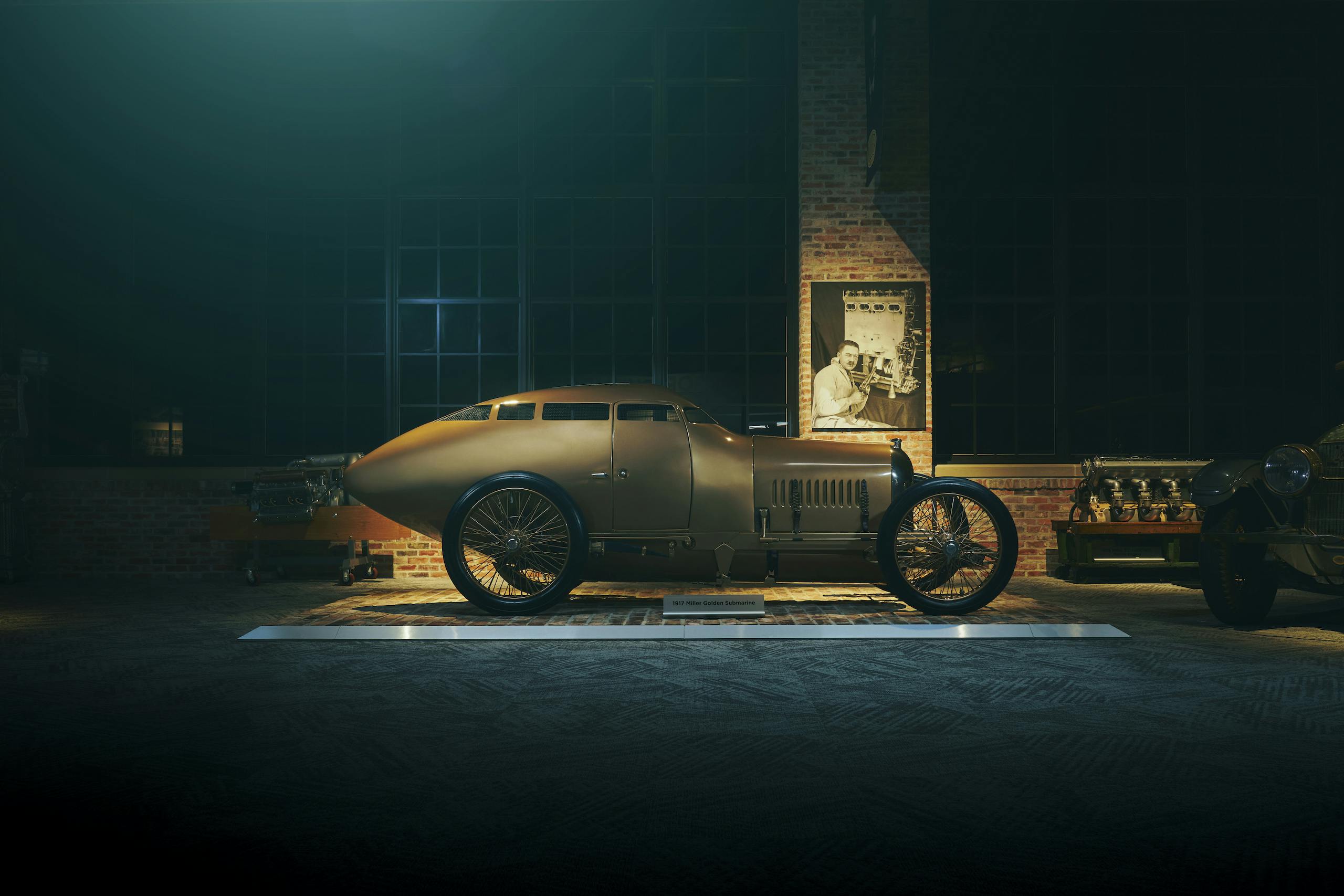
1917 Miller Golden Sub (Replica)
Promise on the hoof.
The second most important piece of the Harry Miller story also lives in Jacksonville, a stone’s throw from the TNT. Or at least, its doppelgänger sits there, because the real thing disappeared long ago.
Unlike most carmakers of his time, Miller believed that racing required unique engineering. Most of his contemporaries simply took to the track with strengthened road cars, but Miller’s products were thoroughbred and specialized, unhappy outside their oval element. And they never looked like anyone else’s work.
Naturally, his first truly original machine was laughed at.
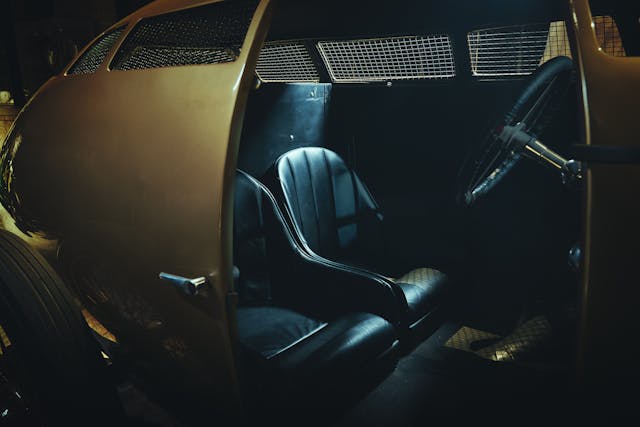
There were nicknames at first, like Stinkbug or Percolator. When the car began to win so much that it couldn’t be ignored, some wag dubbed it Golden Submarine. The name mirrored looks but not purpose. Miller designed the world’s first purpose-built enclosed racing car on commission for America’s first superstar driver, the dirt-track legend Barney Oldfield. Once a household name, Oldfield was then a dimming star who had managed to lived through years of competition, and in old age, he wanted more more safety than an open car could give. Miller saw a chance to cut driver fatigue while adding speed through streamlining. The resulting machine made national news at its launch. By the end of the Sub’s first season, Oldfield had won 17 of 35 starts and broken every international dirt-track speed record on the books.
No one knows what happened to the original Sub. Oldfield ran hot and cold on the car, not least because he nearly died in it twice. The first crash plunged him into a trackside lake. In the second, he was stuck inside during a fuel fire so fierce it destroyed the car’s body. Frustrated, Oldfield cut off the remaining panels, convinced the shape was too dangerous.
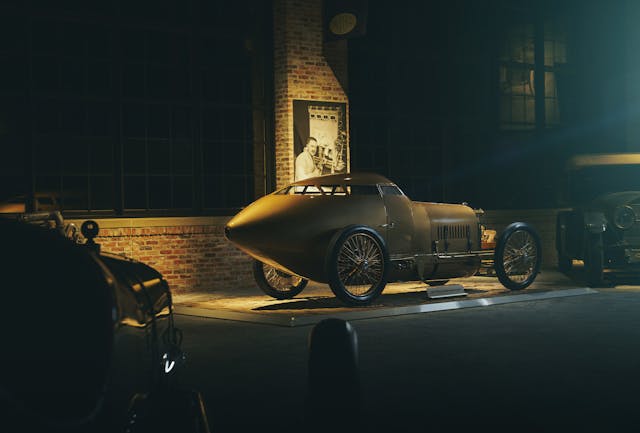
The winning continued for a bit, but the world and Miller moved on. The Brumos Sub is a toolroom copy, as accurate as it gets, drivable. It was built several decades ago from photos. As on the original, the mesh-covered side windows are shorter than most shoeboxes. The thin aluminum body wears no roll structure, just a few pieces of support tubing the thickness of a finger. The single tiny side door is the only way in or out. Oldfield ran the car on dirt, with a four-cylinder, and claimed that the air inside was so still, he could smoke a cigar. (When someone doubted him, he famously proved this, lighting a stogie at speed.) Miller, always thinking bigger, wanted to build a tiny V-12 for the thing but never got the chance.
Next to the TNT, the lineage is obvious. The two cars share a bull nose and thin, elegant frame rails, plus an obvious dusting of obsession. Each car places the tiny gearbox between your legs, the shifter buried beneath a thick wooden steering wheel. You are clearly meant to touch one of those items a great deal and the other almost never.

The back wall of the main room at Brumos holds a photo of Harry Miller, close to life-size, mounted maybe 20 feet in the air. He’s standing on a dusty street outside his Los Angeles storefront in 1917, next to the real and brand-new Golden Sub, wearing a sweater and tie and a slightly irritated look, as if unhappy to be posing and not at work. Even in black and white, the car appears vivid—new but not polished, all gun-blued steel and menace.
I sat in both Millers and wanted to linger but didn’t. Starks gave me permission to crawl inside anything in the museum, but the prewar machinery felt oddly like trespassing. Like a lot of vintage race cars, they represented an odd crux: reliable enough to be demonstrated occasionally, but so fast and dangerous in their intended environment that no one will now demonstrate them there at period speed. Most examples thus spend their lives in calm rooms, full of stories but only able to speak a certain way.
Miller himself died in 1943 at the age of 67, nearly destitute. He had retired comfortably just before the Great Depression but couldn’t stay away from the sport he loved. That tendency saw him solvent for a bit, then bankrupt, then too broke to stay in California, his adopted home. He moved back east, to Detroit, where he lived a hard life, sick with diabetes and cancer and running a small engineering business until his heart gave out. It was definitely not from trying too little.
A family, a product, a family

1953 Porsche 356 Pre-A
The beginning of the end of a beginning.
“We all have a desire,” Ferry Porsche said, “to create something that will show we were here.”
For Porsche, that something was a sports car. That sports car built a company under a family name, and the name became synonymous with a certain kind of thinking—straightforward, with sensible ideas about purpose, but also tilted occasionally by the family’s unique definition of “sense.”
The first production Porsche sports car arrived in 1948. They named it 356/2. It was rear-engined and rear-drive, with an air-cooled flat-four and a heavy debt to Volkswagen engineering. Around 60 such vehicles were built by hand, in both coupe and convertible form, in the Austrian Alps, in a converted sawmill in the small town of Gmünd. Porsche the carmaker had been driven out of its Zuffenhausen facility by Allied bombing in 1944; when the mayor of Gmünd found out, he offered Ferry use of a local mill. The marque’s first real cars were thus born in a crude environment that has nonetheless become something of a Mecca for the Porsche faithful.

Gmünd Porsches are famous for their crude finish. Their panels are often asymmetrical, with exposed body welds and endearing details like headlamps or taillamps mounted at slightly different heights. Next to the later and more refined “normal” 356, a Gmünd is an Impressionist painting, with softer edges but a deeper sense of humanity. That evolution within a form is how Porsche works to this day, and the 356’s change over seven years of production illustrates nothing less than a group of engineers teaching themselves how to be a viable car company. As the 356 grew up, it grew faster and more practical, but none of the later iterations carry the charm of the 356 “Pre-A,” the model built immediately after Gmünd. The moniker is a space-between-spaces, a nickname used to identify the machine in the context of what followed. (Next came the 356A, then the B, and so on.) In hindsight, the car illustrates with stark clarity where Porsche intended to go and what it wished to leave behind.
Pre-As made from 40 to 70 hp, depending on spec. Their angled windshields, initially made from two separate pieces of glass but later a single piece, are said to be “bent,” so sharp is the fold in the middle. Early examples wore unsynchronized VW transaxles and VW-sourced two-piece crankcases. Synchronizers came later, as did a three-piece engine case designed in-house.
Loving a Porsche is about as common as enjoying pizza or the weather in San Diego, but I’ve always found these particular things to fire a unique spark in my brain. A Pre-A can appear almost tentative in detail. The cabins are stark and simple, the switch pulls and trim one step evolved from the sort of thing you’d find in a 1940s hardware store. Stuttgart would later imbue its corporate identity with a certain arrogance—in the company’s responses to mistakes, in its customer relationships, in market approach—but early 356s always exude a certain humility. There is no fussiness to the car’s bits or whole, just simplicity and an obvious sense of pride in work.

Behind the wheel, the thing may as well be a prewar Ford. The giant steering wheel and plain steel dash wouldn’t intimidate a toddler. 356s are notorious for handling quirks—like a VW Beetle, their rear axles can occasionally make speed difficult for a novice driver—but pretty much anyone can drive a 356 at moderate pace without fear. Even an early 911 is less approachable. A 356 just looks and acts like it needs a hug.
In the 1960s and 1970s, the journalist Denis Jenkinson wrote often about how Porsche had changed in his lifetime, not always for the better. Jenks was an early adopter, buying his 356 in the 1950s, when the marque’s fans were limited to a tiny and cheerful cult. His writing initially struck me as grumpy, but in retrospect, it was just the aftermath of a company that viewed its familial roots as starting point, not end. It reminded me of the old line about New York City—how that city’s best era always seems to be the one in which you discovered it.
The Brumos Pre-A is a restoration, but a clean and thorough one, a deep liquid red. Tight panel gaps. I opened the door and shut it again, listening to the hollow, resounding thonk. The sound echoed through the building for a moment, lasting longer than expected, as if it didn’t want to die away.
Porsche goes big

1972 Porsche 917/10
Raw power, an end in itself.
There are two Porsche 917s in the Brumos Collection. One is a Gulf-liveried 917K used in the Steve McQueen movie Le Mans. The other is a 917/10, the K’s younger, turbocharged sibling. Both models are capable of more than 200 mph and built of aluminum tube and fiberglass. People are often drawn to the K, and for obvious reasons. I always get pulled in by the /10.
The 917/10 came from a sea-change moment in Porsche’s history. The car was built for the American Can-Am series, a road-racing environment virtually free of rules and dominated at the time by English constructor McLaren. Porsche wanted in, and so the company’s engineers took a 917, the company’s Le Mans winner, and went ape. The 917’s flat-twelve gained turbocharging and extensive reengineering, plus hundreds more horsepower. The act reflected the time: As the car grew more complex, so did its maker; Porsche was at the time climbing from small family firm to larger corporate clockwork.

Most of the 917’s reengineering work was done in concert with American motorsport impresario Roger Penske, who ran Porsche’s Can-Am efforts in America. Penske, in turn, leaned on his primary engineering asset, a clear-thinking race driver from New Jersey named Mark Donohue. In his book The Unfair Advantage, Donohue talks about heading to Stuttgart to investigate the early stages of the 917/10 program, waking to the full potential of the Germans’ efforts. Porsche was in the midst of something big, he wrote, but even so, their new car was no match for the McLarens. The first prototype that Donohue drove had more than 1500 test miles on the clock by the time he first strapped in, but the car weaved so much at 150 mph, he had to jam his legs against the steering wheel to keep a straight course.
Still, they persevered. After just a few hours of R&D, the American broke the lap record at Porsche’s test track by whole seconds. Later, when a German engineer asked him about horsepower needs, Donohue spat out one of the most famous lines in all of racing: The car will have enough, he said, when I can spin the rear wheels at the end of the longest straight in top gear.
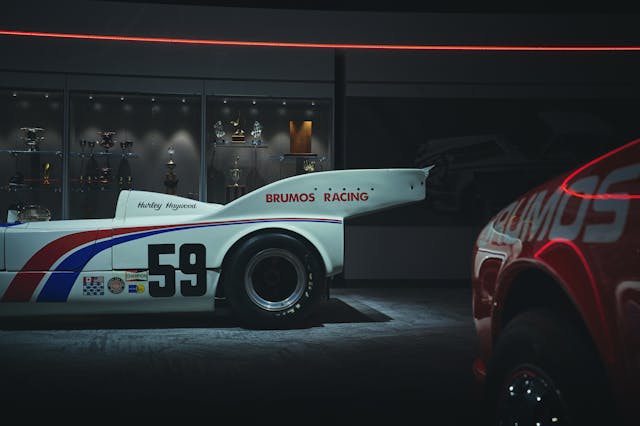
Progress came quickly. Early on, the car made 880 horses from an air-cooled, turbocharged 5.0-liter. In 1973, the answer changed to a 5.4 making 1190. Donohue devoted long hours to making the /10 competitive and predictable, and then he crashed in testing at Road Atlanta. The car was mangled, but more important, Roger Penske’s star driver was forced to sit out a season in physical recovery while other Penske ’shoes took his girl to the front in race after race. Mere months later, if you were racing in the Can-Am without a turbo 917, you didn’t have a chance.
But then, that was the Can-Am. Porsche’s next project, the 917/30, was also a joint Penske-Donohue project. As a competition device, it was so potent as to essentially murder the series. No one else could compete.
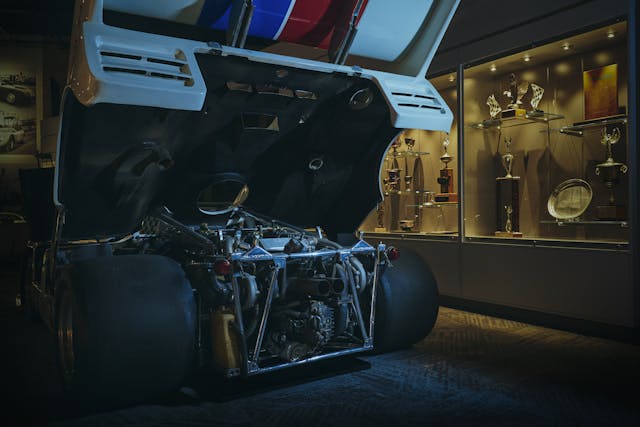
Oh, the zillion ways a 917/10 could kill you. Standing next to the car, in a dark and quiet room, you picture all of them. We lifted the engine cover, propped it up with a stick, poked and gaped at hoses and manifolds, tried to stick arms through the plumbing to touch the distant block. No part of the car appeared big enough to do its job, except the select few bits that seemed stout enough to hold up a truck.
Many Porsche race cars seem approachable in layout, and when you drive them at the limit, they are. There is nothing approachable here in the slightest. If you see anything in the cockpit outside that 10,000-rpm tach and the enormous boost knob, you are looking in the wrong place. Those two items are surrounded by a contradiction of what seems like too many tiny frame tubes but also entirely too much open air. If you sit in the car with the body off, a 917/10 reveals itself as mostly a lot of nothing, those tubes and fuel tanks essentially stopping just below your shoulders.
When Donohue’s car came to a stop after the accident, he was left with little more than an engine and a seat bolted to an aluminum bulkhead. His legs were out in the breeze and the rest of the car was gone. My size-11 shoes barely fit in the footwell. At the wheel, I turned around, saw only a pile of heat waiting to happen.
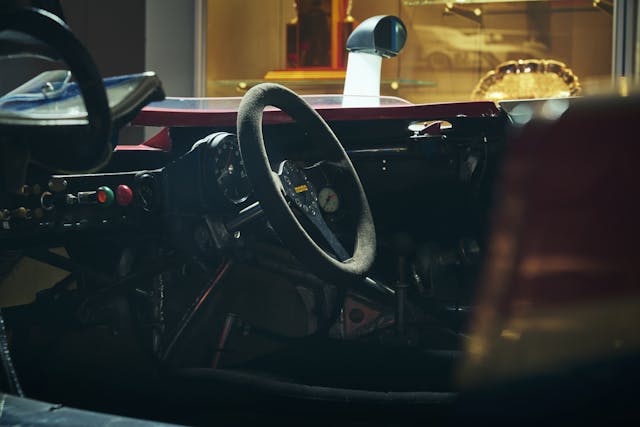
The Brumos 917/10 was originally driven by the Jacksonville team’s house star, Hurley Haywood. I hung out with Hurley a bit, several years ago, at a small dinner in California, attempting to keep the conversation away from cars. (If you want to know anything real about a racing driver, ask about anything but their racing career.) One car kept coming up, however.
“Did you . . . like the 917/10?”
“Oh, that?” Dismissive.
“Yes.”
“I mean . . .” A head tilt and sigh. “I was young and dumb.”
It was fast, he said, and good. But of course it was. He wouldn’t do it again, he said. He was not smiling when he said that, and I loved that fact, though I couldn’t say why, and still cannot.

